Architecture Lover’s Guide: 10 Beautiful Buildings in Venice
WanderInEurope is reader-supported. Affiliate links and ads help us keep creating useful content for you.
I’m the kind of person who’s totally into old architecture, and Venice is at the top of my bucket list for so many reasons!
Obviously, there’s the amazing architecture: Venice is like a melting pot of styles, with Gothic, Renaissance, Byzantine, and even Islamic influences. The buildings, canals, bridges, and churches are just so beautiful to look at. I wouldn’t even mind getting my feet wet from the Venetian floods just to soak in all those architectural wonders. Let me give you a rundown of 10 buildings in Venice that I think are absolutely stunning!
Saint Mark’s Basilica


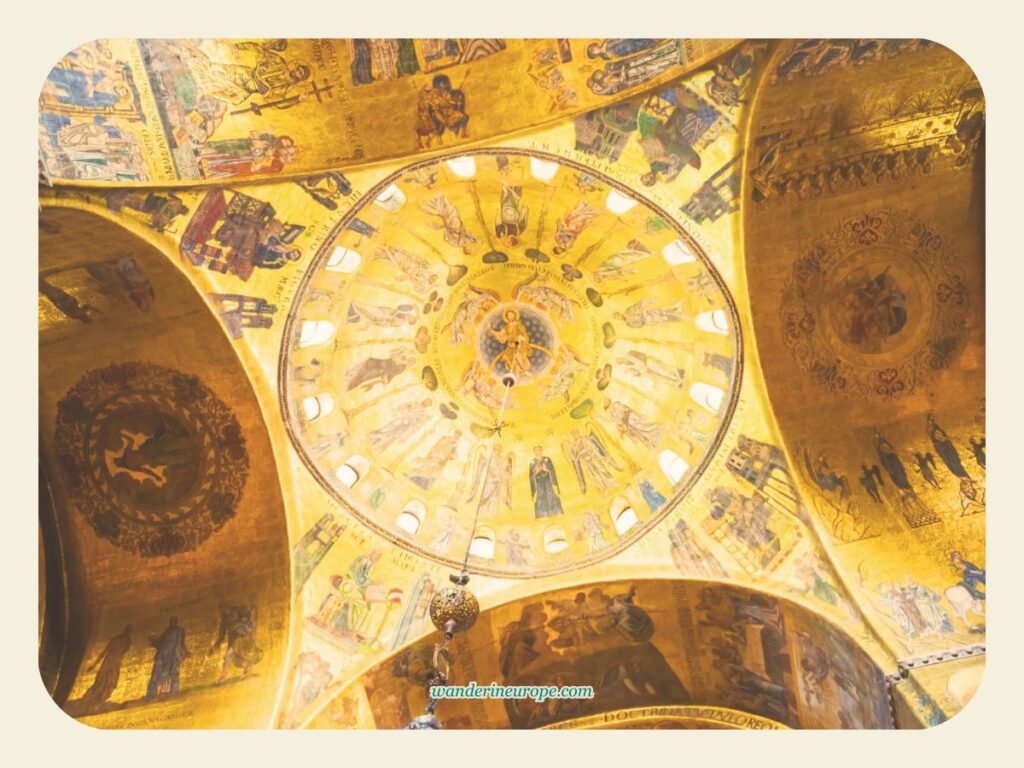
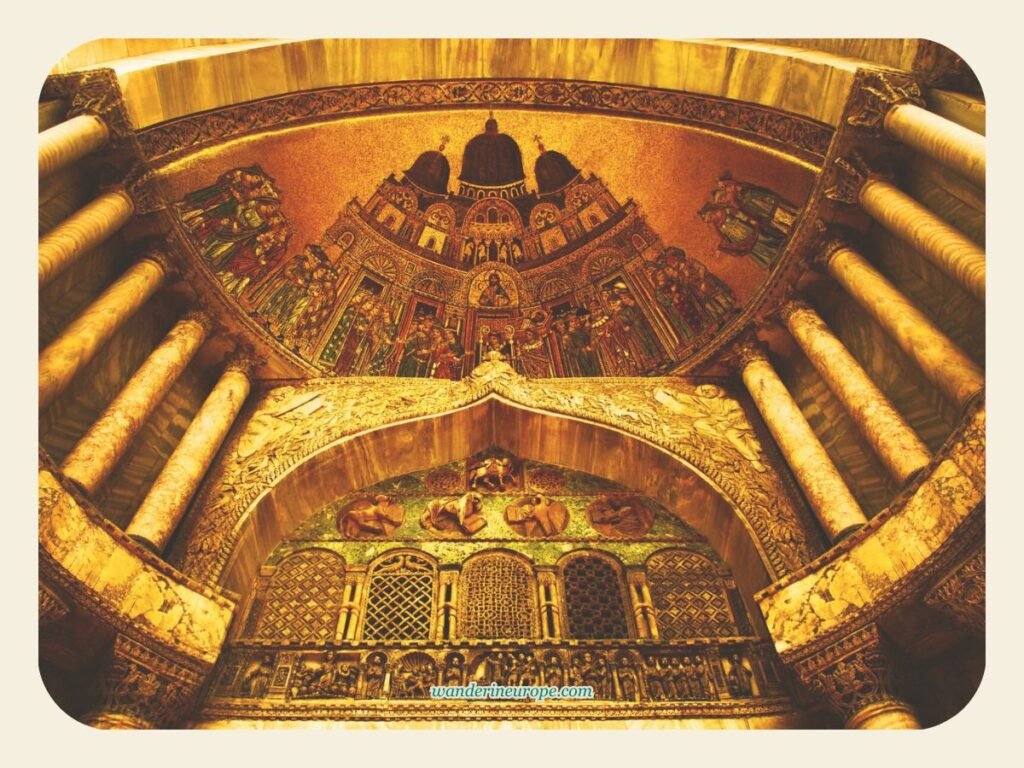
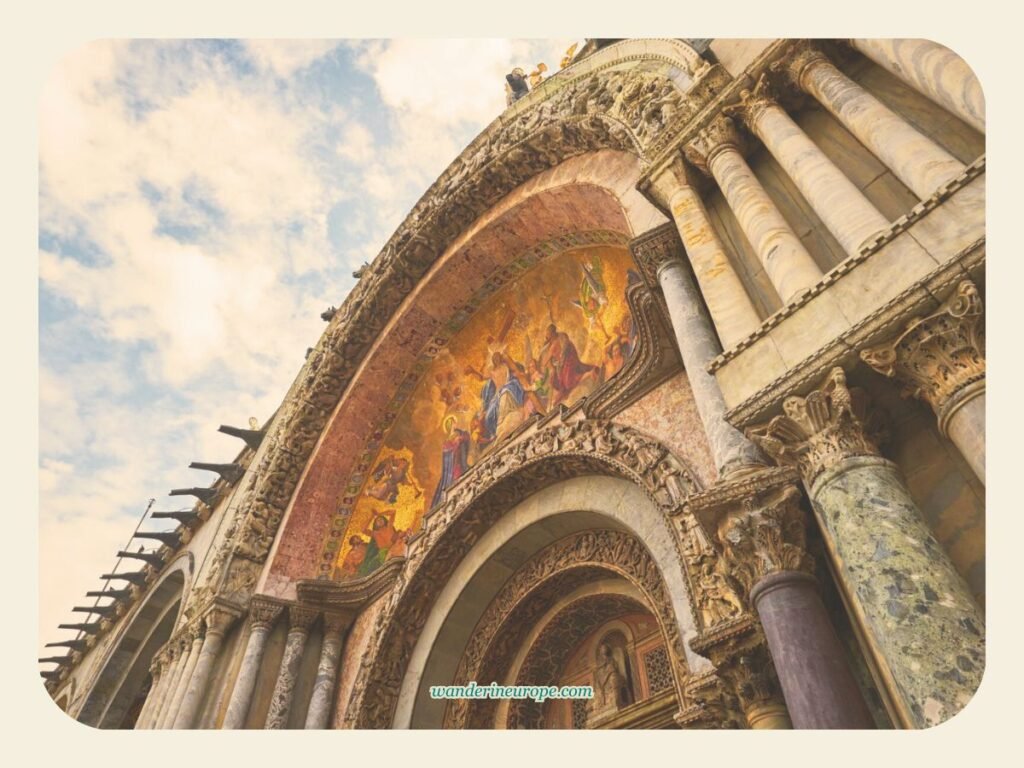

We kick off our tour of Venice’s amazing buildings with the famous Saint Mark’s Basilica, also known as the Patriarchal Cathedral Basilica of Saint Mark. This architectural gem is just east of Saint Mark’s Square, which was once the heart of political and religious life during the Republic of Venice.
The basilica was first built in the 9th century, but it has been rebuilt multiple times. The design we see today mostly comes from its third reconstruction, completed in 1094.
Its architectural style, influenced by the culture of Constantinople, blends Roman grandeur with Eastern opulence. The basilica’s design, inspired by the Church of the Twelve Apostles in Constantinople, showcases the cultural exchange of the time. This basilica is a geometric and symmetrical marvel, with a Greek cross inside a rectangle and five main domes. Each dome glows like a celestial body, lighting up the intricate mosaics and carvings below.
Saint Mark’s Basilica has three sides—north, south, and west. The west side, facing Saint Mark’s Square, is especially stunning. It’s so detailed that you can’t take it all in at once. This side of the basilica has five portals, each decorated with important religious carvings.
Above each doorway, there are two arches filled with beautiful mosaics that tell Bible stories. The largest doorway and the windows above it are topped with a golden Winged Lion, the symbol of Venice and its patron saint, Saint Mark.
Step into Saint Mark’s Basilica in Venice, and you’ll be surrounded by gold. Yes, you heard that right. The walls and ceiling are covered in golden mosaics.
These mosaics span an incredible 8,000 square meters (or 86,111 square feet) of the basilica’s interior and took over 800 years to complete. Imagine the amount of work that went into this masterpiece! The mosaics depict religious inscriptions and images of saints against a shining golden background, telling the history of Christianity. It’s a breathtaking sight that can give anyone goosebumps, especially if you’re Catholic.
One of the most magical times to visit the Basilica is during the evening tour. As daylight fades and the Basilica lights up, the mosaics seem to come to life, showing details you might miss during the day.
Lastly, be sure to check out the view from the terraces, where you can get a unique perspective of Venice and appreciate the Basilica’s architectural details from a different angle.
Planning a visit? You can tickets online from the official webshop.
Basilica di Santa Maria Della Salute

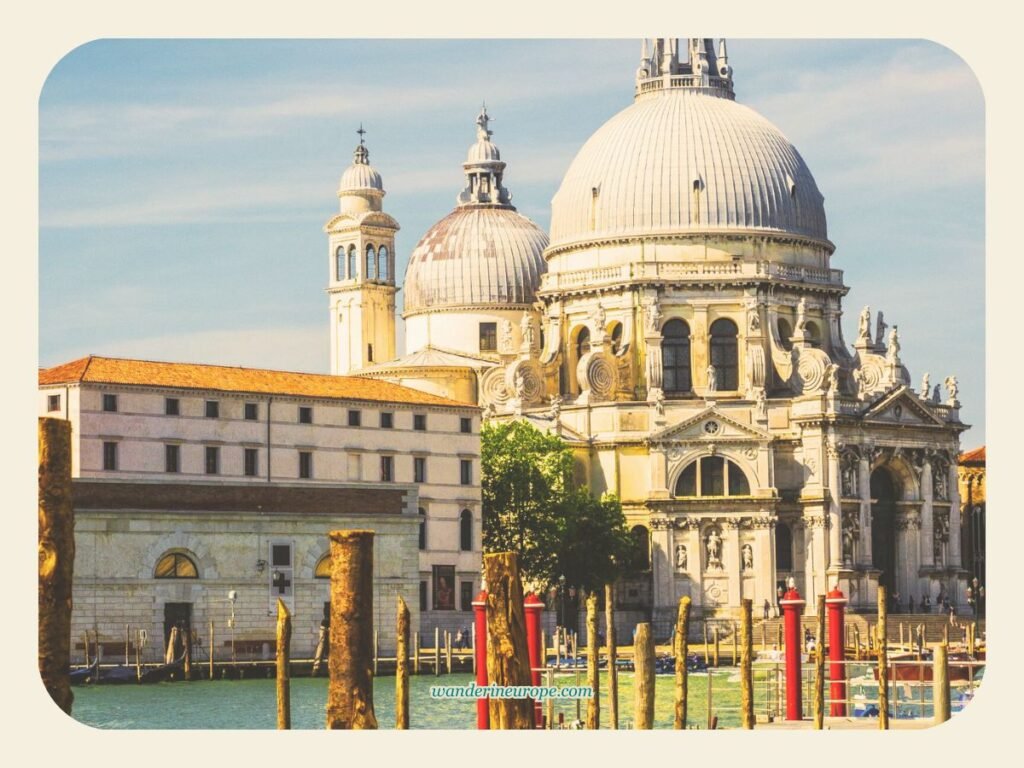
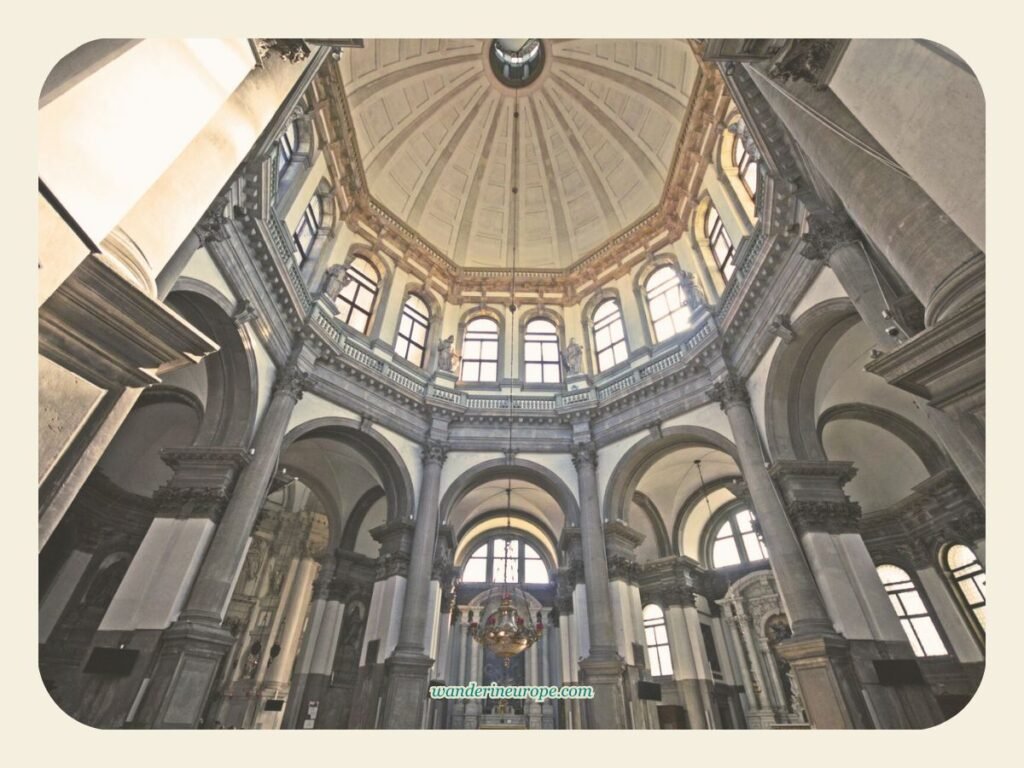
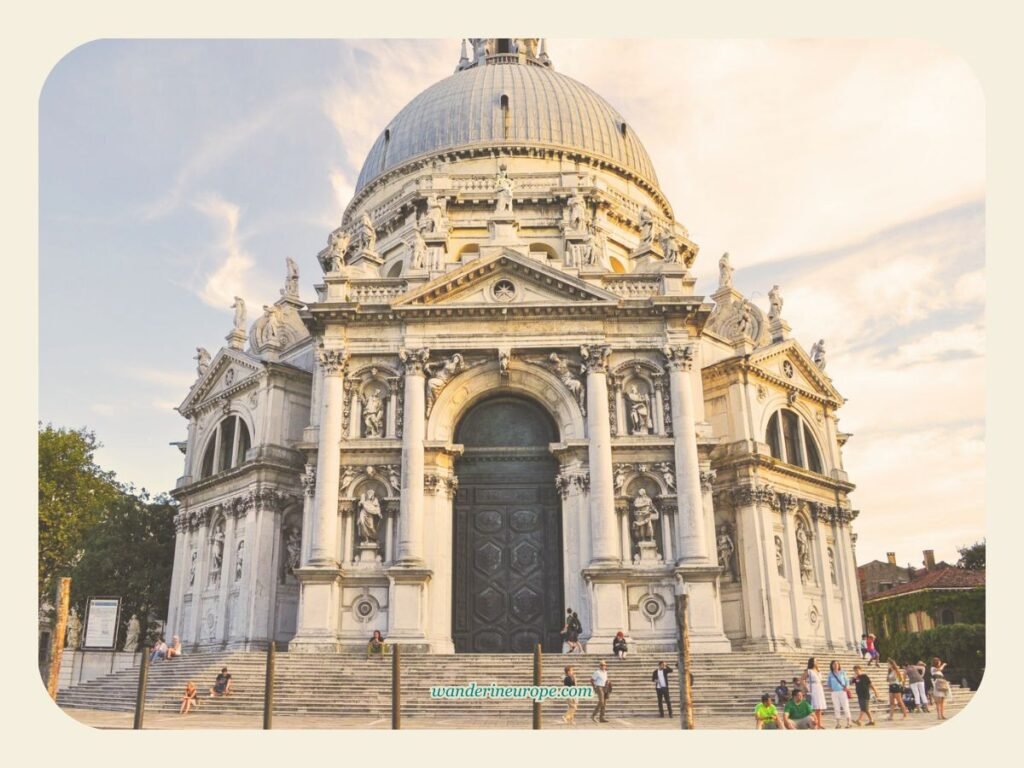
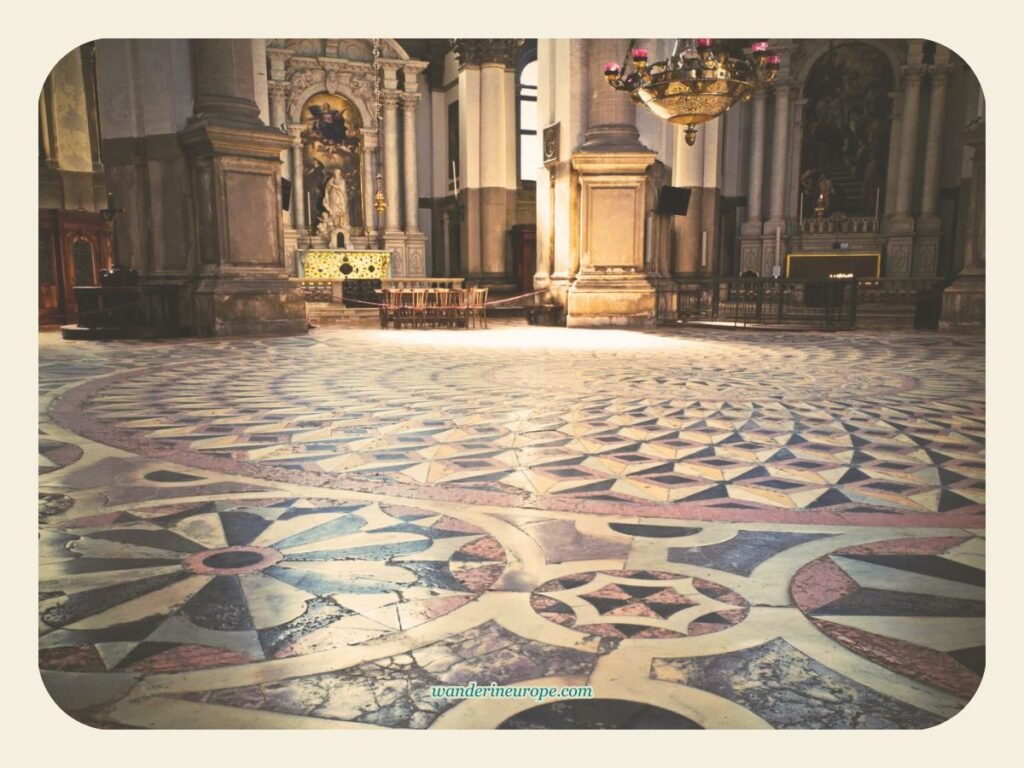

As we continue exploring Venice, we encounter an amazing structure at the entrance of the Grand Canal. It’s the Basilica di Santa Maria Della Salute, or simply ‘Salute’ as most people call it.
The Basilica di Santa Maria Della Salute, built in the 17th century, is a symbol of gratitude to Our Lady of Health. This beautiful Baroque church was constructed after the Black Plague that swept across Europe, as a token of thanks for deliverance from the disease. This is why, inside the Salute, you’ll find artworks referencing the Black Plague.
Fun fact: Istrian stone and Marmorino are the main materials used in the construction of the Basilica di Santa Maria Della Salute.
More interesting fact: The Basilica’s iconic presence in the Venetian skyline has inspired many artists, including Canaletto, who painted the “Entrance to the Grand Canal” with Venetians sailing in front of the Basilica.
While the Basilica di Santa Maria Della Salute may not be as ornate on the outside as the Basilica Cattedrale Patriarcale di San Marco, it’s full of fascinating Marian symbolism. The church’s grand dome represents Mary’s crown, and the vast interior space symbolizes her womb. The church’s octagonal design, with its eight sides, refers to the eight points on Mary’s symbolic star.
The basilica features 125 sculptures of various saints, evangelists, and prophets, which add plenty of visual interest for visitors. Inside, you’ll discover amazing paintings by Titian and Tintoretto, including Tintoretto’s “Marriage at Cana.”
There are several spots in Venice where you can get a fantastic view of the Basilica di Santa Maria della Salute:
- The Terrace of St. Mark’s Basilica: This terrace runs along the west and south façades of the basilica. From here, you can enjoy a wonderful view of the Basilica di Santa Maria della Salute, St. Mark’s Square, Torre dell’Orologio, the Doge’s Palace, and the Venetian lagoon.
- Onboard a Boat on the Grand Canal: One of the best views of Santa Maria della Salute is from a boat, sailing down the Grand Canal.
For updates and more information about Basilica di Santa Maria della Salute, please see its official website.
Ca’ d’Oro

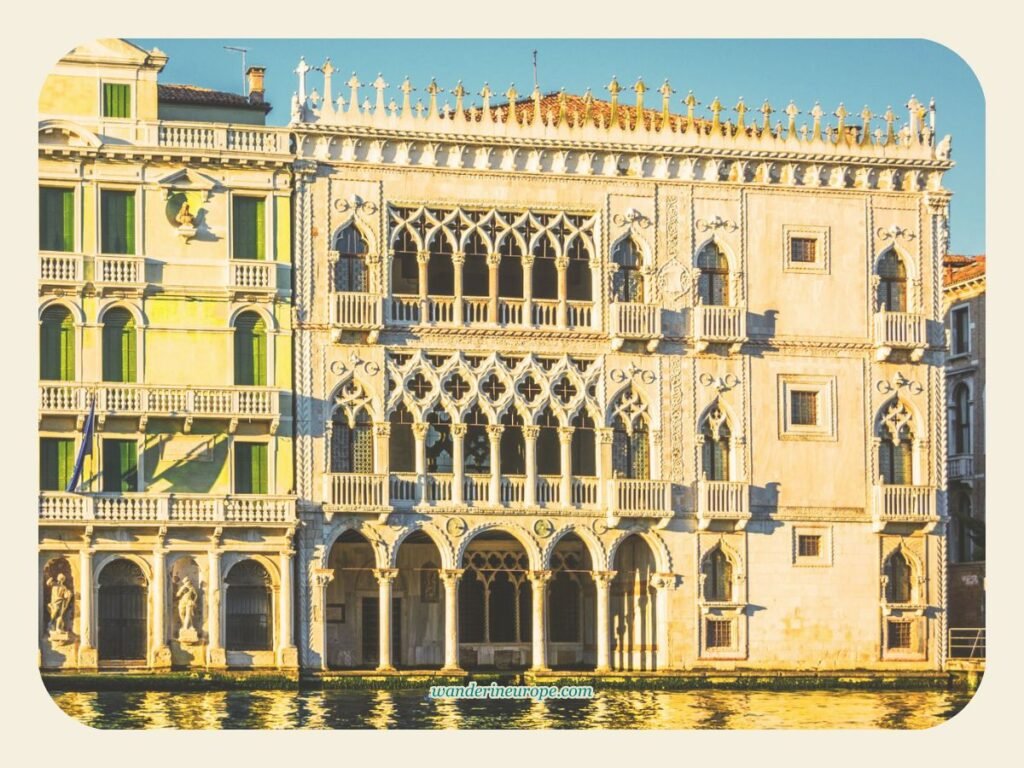
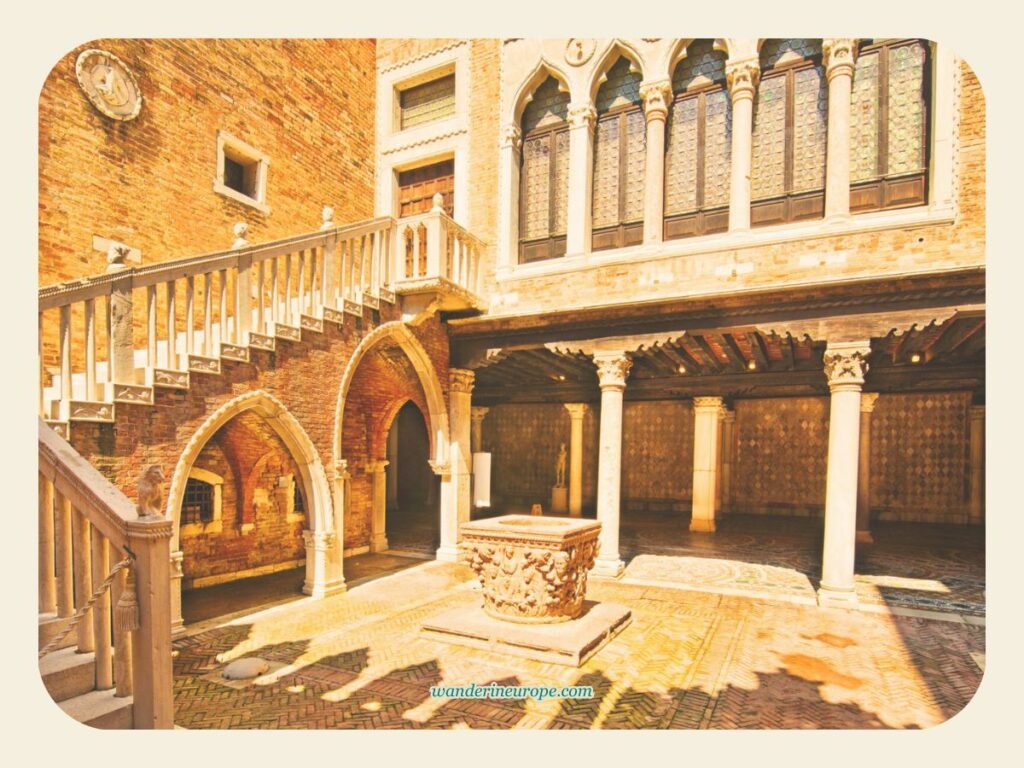

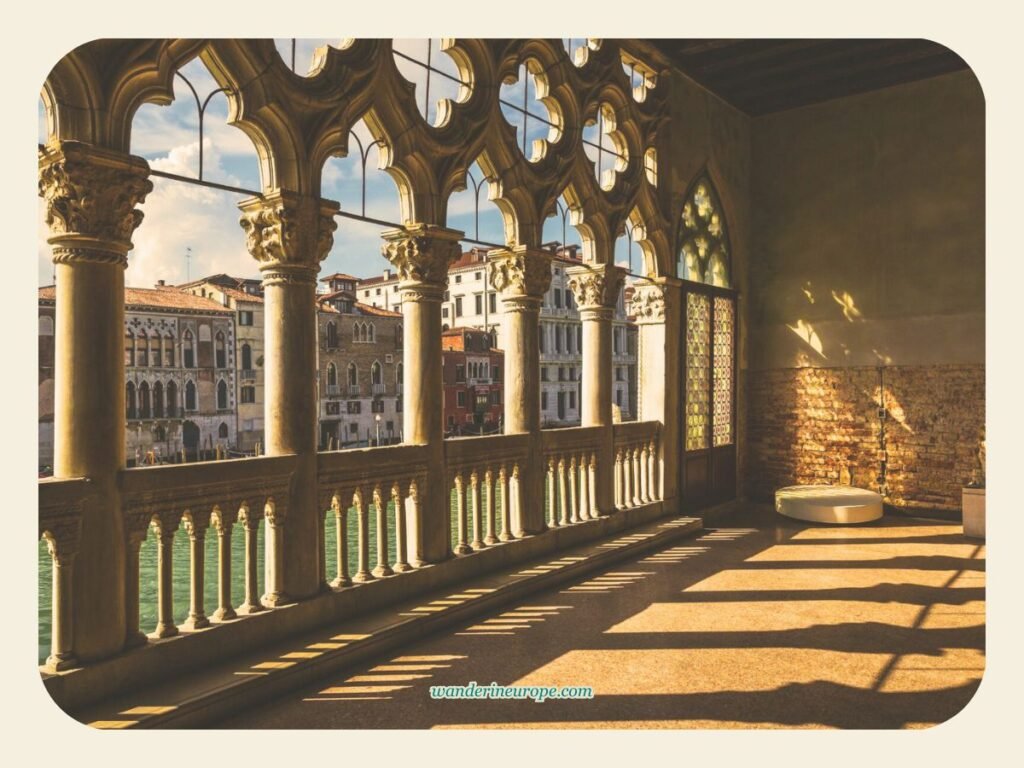

Next up on our list is the Ca’ d’Oro, also known as the Palazzo Santa Sofia. This 15th-century palace is situated along the Grand Canal (it has its own station just a stone’s throw away from the Rialto bridge).
The Ca’ d’Oro is considered one of the finest examples of Venetian Gothic architecture still standing, blending Gothic, Moorish, and Byzantine styles into a unique aesthetic. Its facade is adorned with floral Venetian Gothic elements, much like the famous Doge’s Palace we discussed earlier.
However, the palace isn’t just for sightseeing—you can actually go inside! It’s like a time capsule, filled with artworks by Titian and Van Dyck, along with other Renaissance relics. Why? Because it’s now home to the Galleria Giorgio Franchetti, where you can see sculptures and paintings from the 15th to 17th centuries. One remarkable piece is the ‘Madonna and Child’ by Michele Giambono.
Ca’ d’Oro has three stories, which you can easily spot by looking at its charming facade. The ground level features a covered outdoor walkway with five arches. The second and third levels have balconies, each supported by five pillars and topped with quatrefoil window designs.
The architectural harmony between the two balconies is truly impressive. The alignment of the arches and pillars, along with the quatrefoil windows above each pillar, creates a mesmerizing pattern. Additional details like the roof decorations, rectangular window frames, and wavy edges enhance the elegance of Ca’ d’Oro.
The interiors of Ca’ d’Oro are just as stunning. The floor patterns in the building’s portego, known as Cosmatesque, are incredibly photogenic, showcasing the beauty of Medieval Italian architecture.
If you’re planning a visit, you can find the visitor information on its official website.
Ca’ Rezzonico


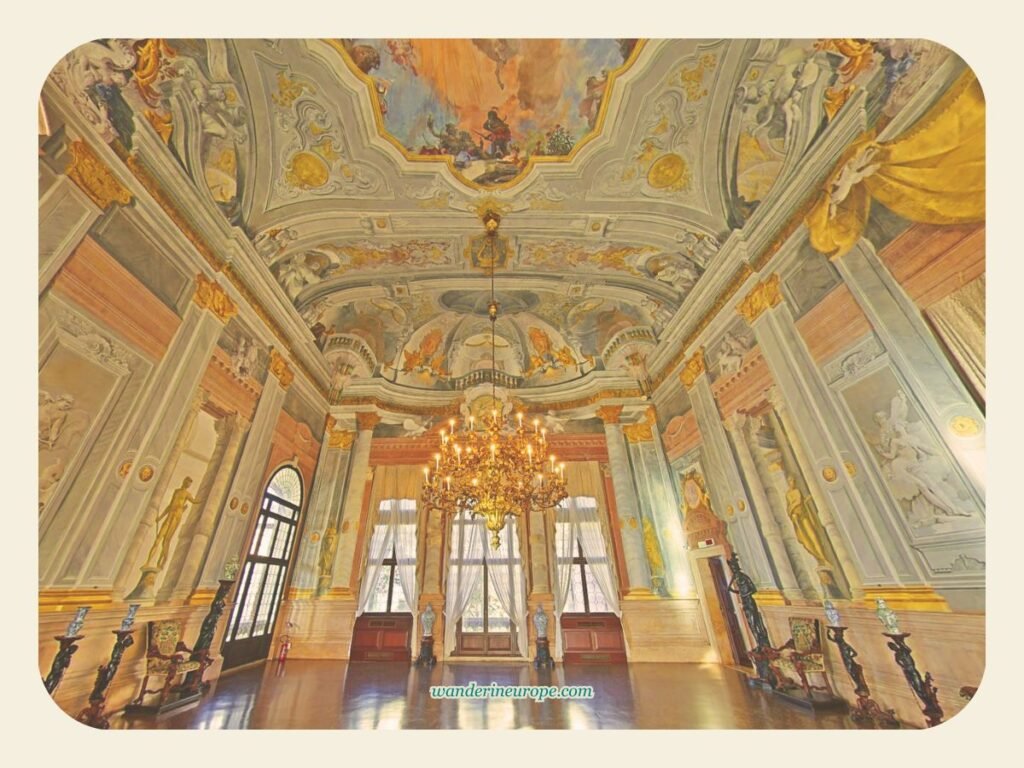
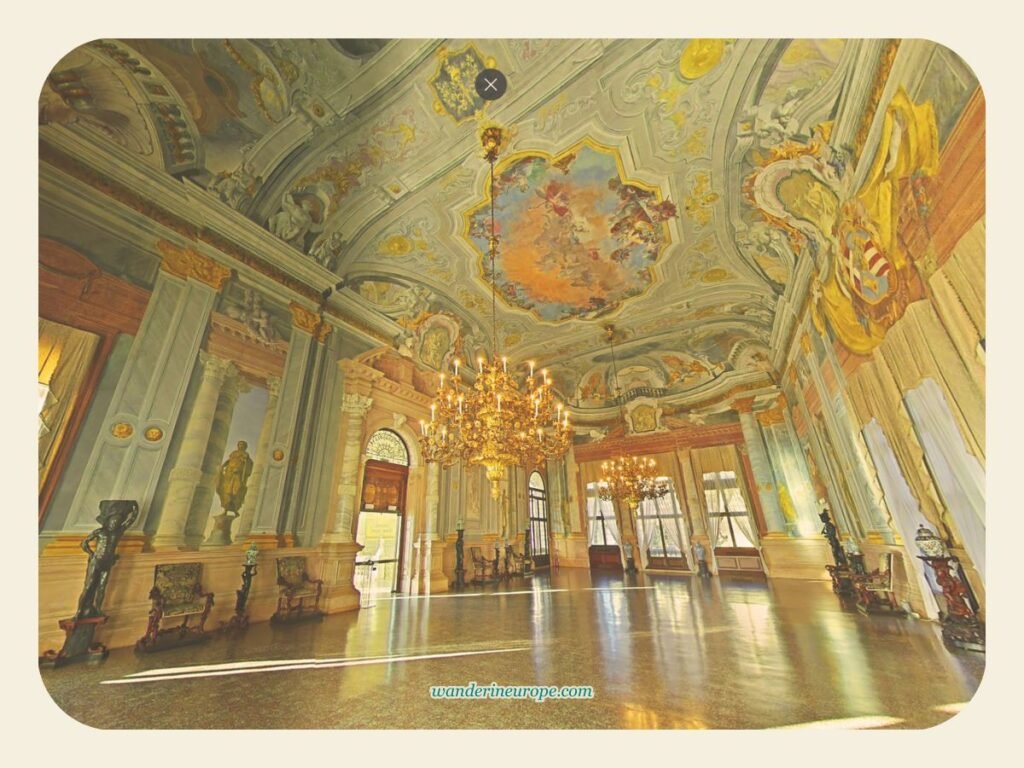
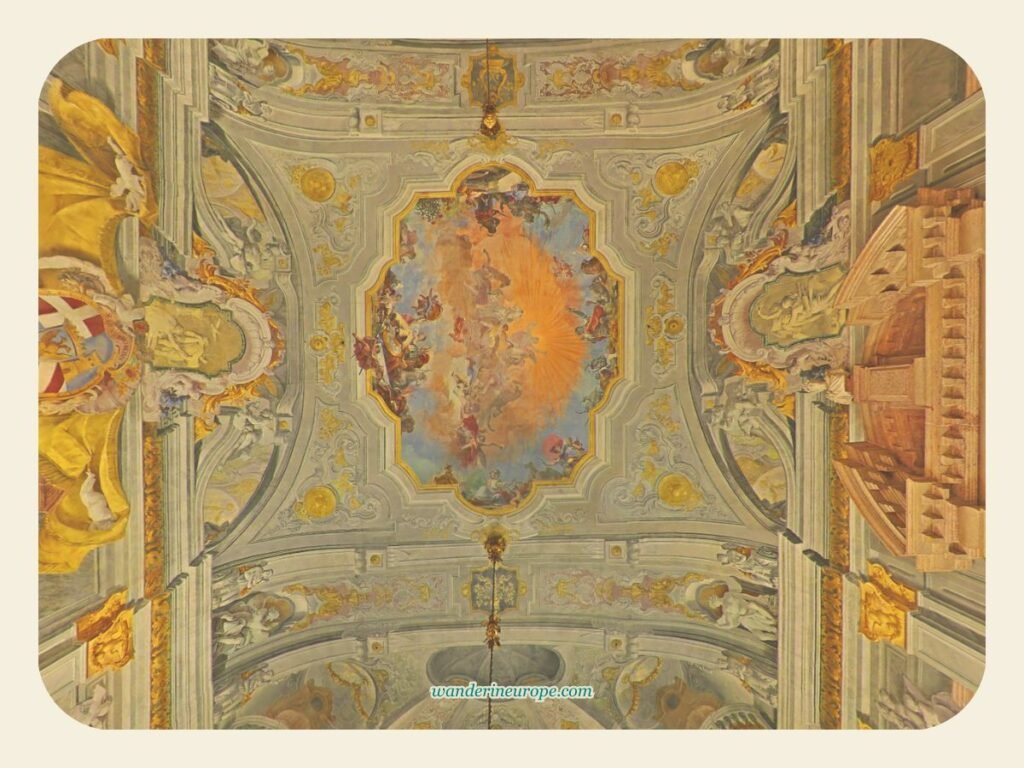
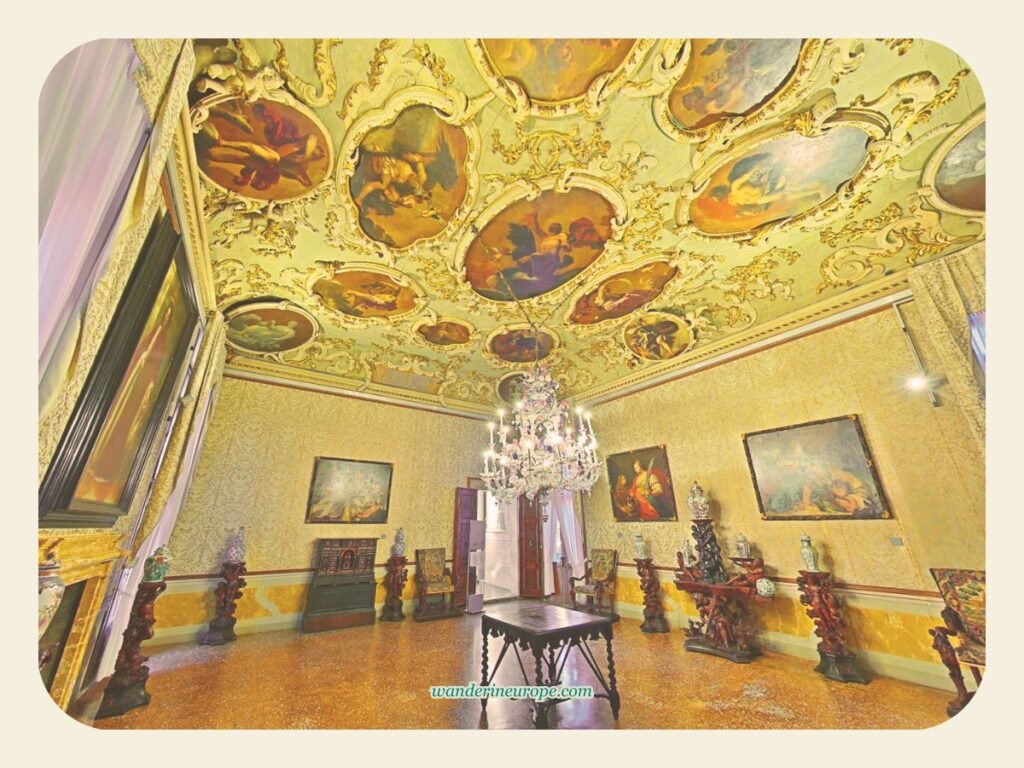

Ca’ Rezzonico, another impressive building in Venice, is a palace that also serves as a museum.
It features stunning Venetian rococo and baroque architecture and houses a collection of 18th-century Venetian art. Managed by the Fondazione Musei Civici di Venezia, this public museum is located along the Grand Canal in the Dorsoduro district, much like Ca’ d’Oro.
Ca’ Rezzonico’s splendor showcases the creative genius of its architects, Baldassare Longhena and Giorgio Massari, who were among the most renowned Baroque architects in Venice at the time. Although the construction initially faced financial challenges, the building eventually became a successful project. Today, its facade, adorned with white marble columns, sculptures, and bas-reliefs, mesmerizes visitors traveling along the Grand Canal.
The true wonder of Ca’ Rezzonico lies inside its walls, where it displays some of the most remarkable 18th-century Venetian paintings. You’ll find masterpieces by renowned artists like Giambattista Tiepolo, Giandomenico, Canaletto, Rosalba Carriera, and others.
The building has four floors, but the first floor is particularly impressive. Out of the 11 rooms in Ca’ Rezzonico, three are sure to leave you in awe: Tiepolo’s Room, the Ballroom, and the Room of the Nuptial Allegory. Be prepared to look up, as the frescoes and paintings in these rooms are truly exceptional.
The Ballroom, with its ceiling frescoes and two grand chandeliers, is especially stunning. At the center of the ceiling is a fresco by Giovanni Battista Crosato, depicting the chariot of Phoebus. Surrounding the chariot are representations of life on the four continents: Africa, America, Asia, and Europe.
If you’re interested in learning more about the Ca’ Rezzonico museum, you can download the PDF file from the official Fondazione Musei Civici di Venezia website. The PDF includes details about the history, building layout, collections, maps, and other general information about Ca’ Rezzonico.
You can buy tickets right on the official Ca’ Rezzonico website. You can also check out the opening hours and other visitor info there.
Doge’s Palace

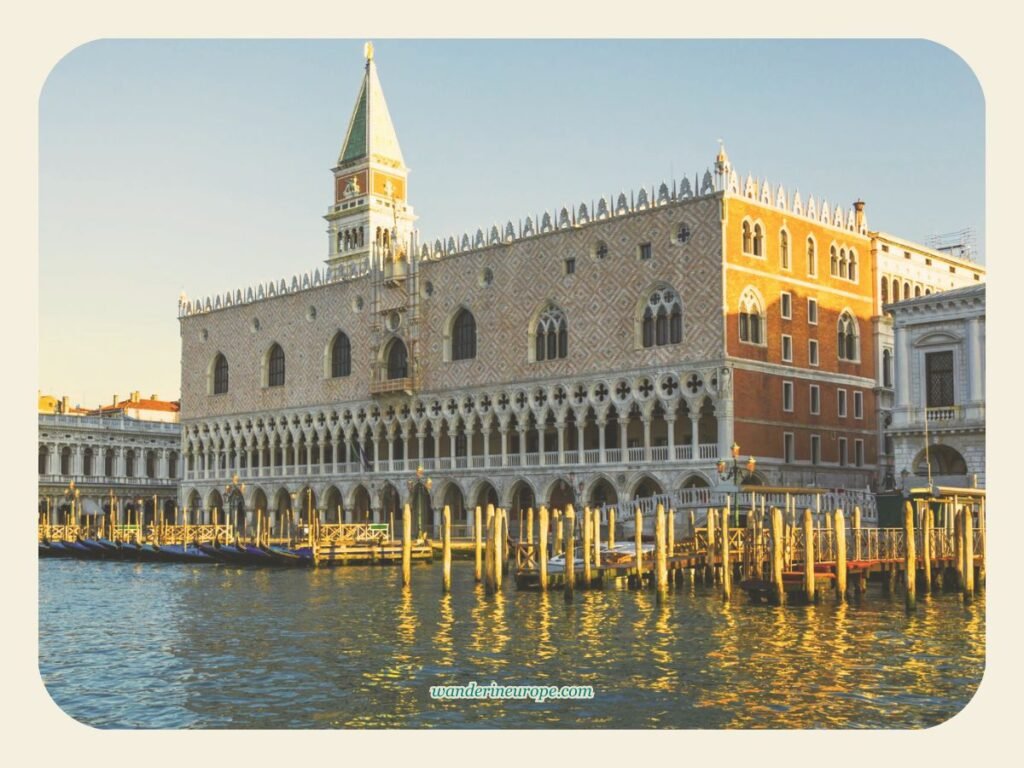
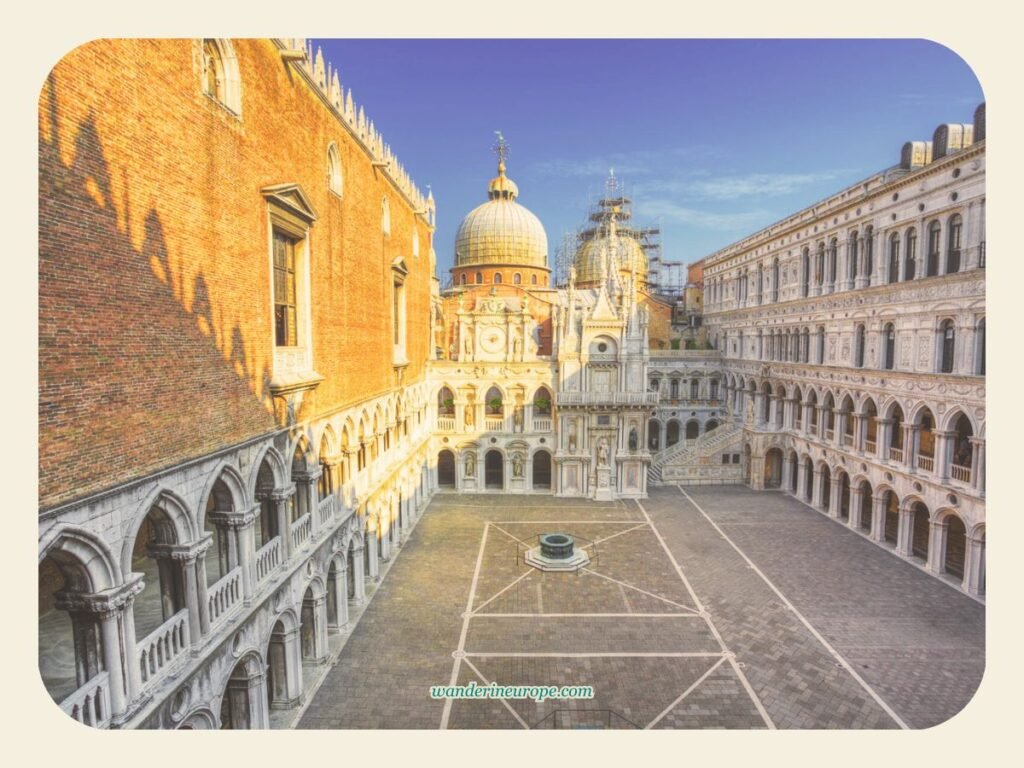
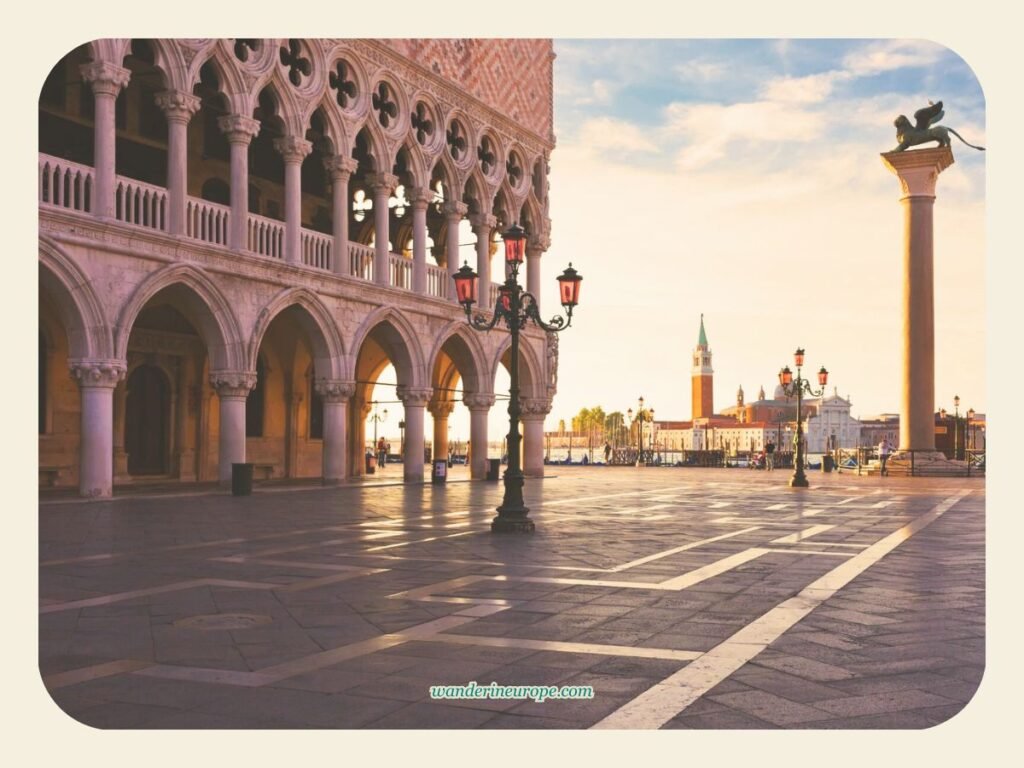
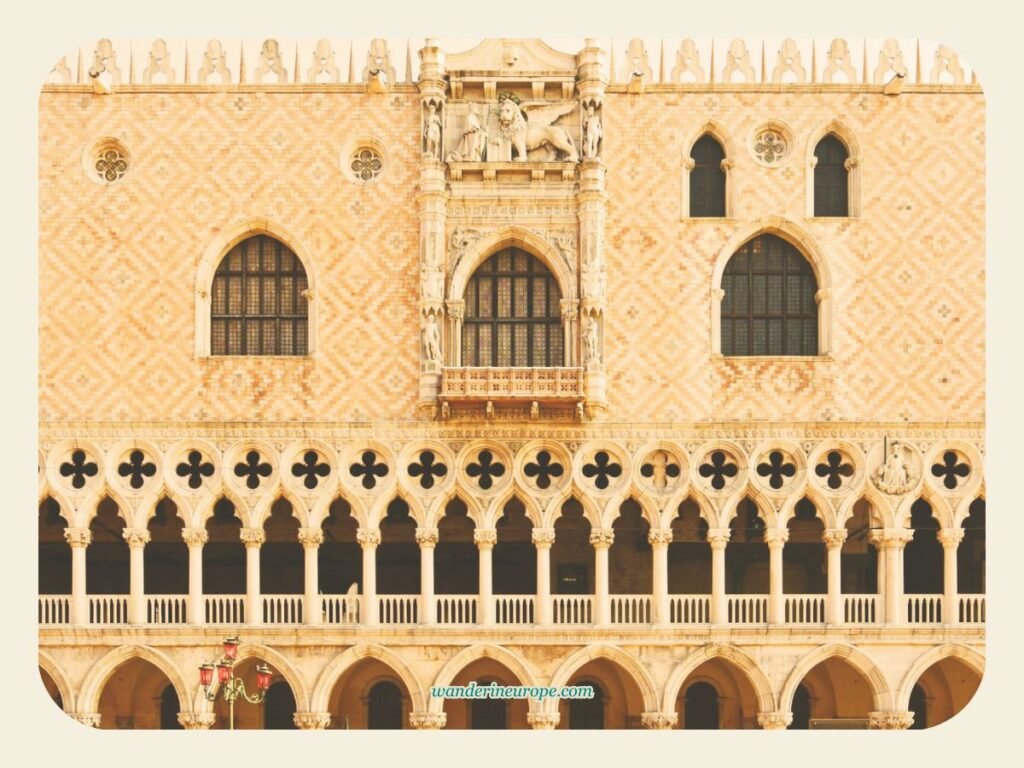

Besides the Basilica of Saint Mark, another stunning landmark in Saint Mark’s Square is the Doge’s Palace, also known as Palazzo Ducale or the Duke’s Palace. It’s considered one of the most beautiful buildings in Venice for many reasons.
Historically, it was the residence of the leader of the Republic of Venice (Doge) from 726 to 1797 and served as the city’s center of power for centuries before becoming a museum in 1923.
Over the centuries, it underwent multiple expansions, renovations, and even partial demolitions to keep up with the city’s changing needs. The palace has witnessed key moments in history, including Venice’s fall to Napoleon in 1797, which marked the end of the Venetian Republic. After Venice became part of Italy in 1866, the palace became state property.
Many notable figures have ties to the palace, including Giacomo Casanova, the famous Italian adventurer who was imprisoned there in 1755. Today, it operates as a museum, one of 11 run by the Fondazione Musei Civici di Venezia, offering visitors a chance to step back in time and experience Venice’s rich history.
The Doge’s Palace is a stunning example of Gothic architecture, especially the unique Venetian Gothic style seen in both its original design and its current form. Its facade features intricate decorations, marble columns, and pointed arches, making it one of the most recognizable buildings in Venice.
Inside, the grand halls are decorated with frescoes and artwork by famous Venetian artists like Tintoretto, Veronese, Tiepolo, and Bellini. These masterpieces help tell the story of the Venetian Republic, bringing its rich history to life.
One of the most impressive features inside the Doge’s Palace is the Giant’s Staircase, where statues of Poseidon and Mars symbolize Venice’s dominance in trade and politics. Between them sits the winged lion, the emblem of St. Mark, the city’s patron saint. Designed by architect Antonio Rizzo between 1484 and 1491, the staircase is a masterpiece of Venetian Renaissance architecture and held great political significance for the Republic.
In addition to the marble sculptures, each step is decorated with intricate patterns created using the niello technique, a method popular during the Middle Ages and Renaissance that features blackened engravings of plants and other natural symbols.
Interestingly, this staircase was where newly elected Doges would receive the Doge’s horn, a symbol of their authority, and swear allegiance to the Republic.
Another remarkable feature is the Great Council Chamber, one of the largest rooms in Europe. The walls are covered with stunning artworks that illustrate Venice’s past. Standing in the room, you can almost imagine the voices of past Senate members debating important decisions that shaped the city’s future.
Once inside, your eyes will naturally be drawn to the ceiling, where golden decorations frame 76 portraits of the Doges, painted by Tintoretto. These portraits line three sides of the room, each representing a piece of Venice’s political history.
On the back wall, you’ll find one of the largest oil paintings on canvas in the world—The Glory of Paradise by Jacopo Tintoretto. This massive artwork is a stunning depiction of heaven, filled with grandeur and brilliance.
Planning to visit soon? There’s a combined tour of Doge’s Palace and Saint Mark’s Basilica for a smoother experience. For more details, check out the official Doge’s Palace website.
La Fenice


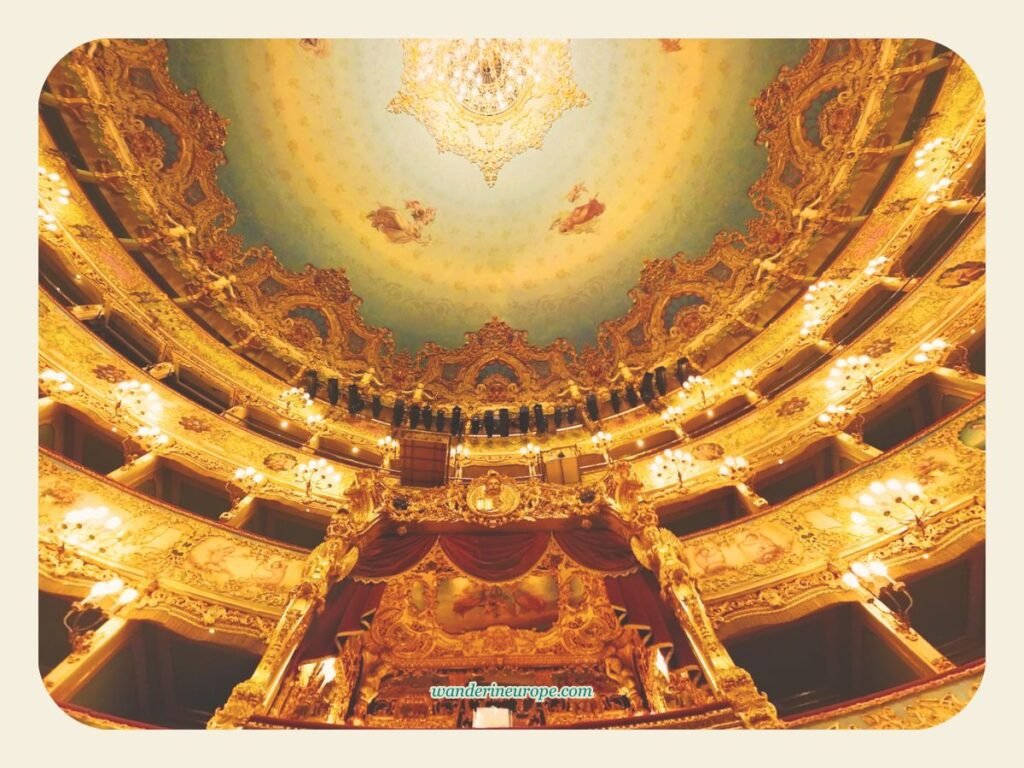
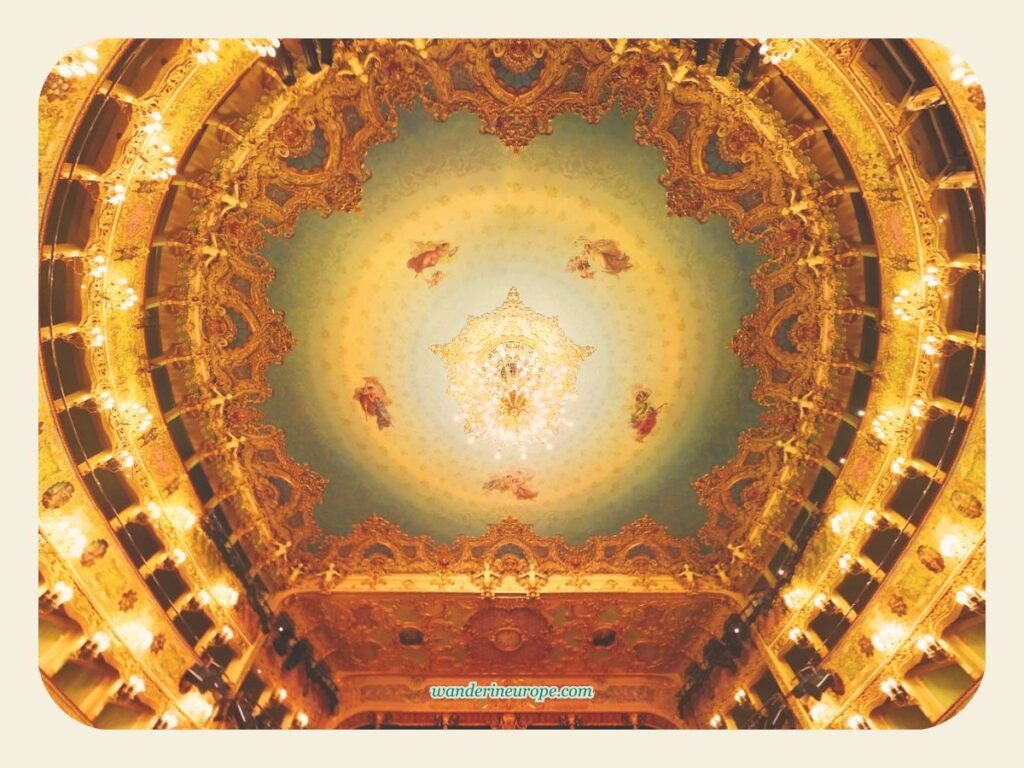
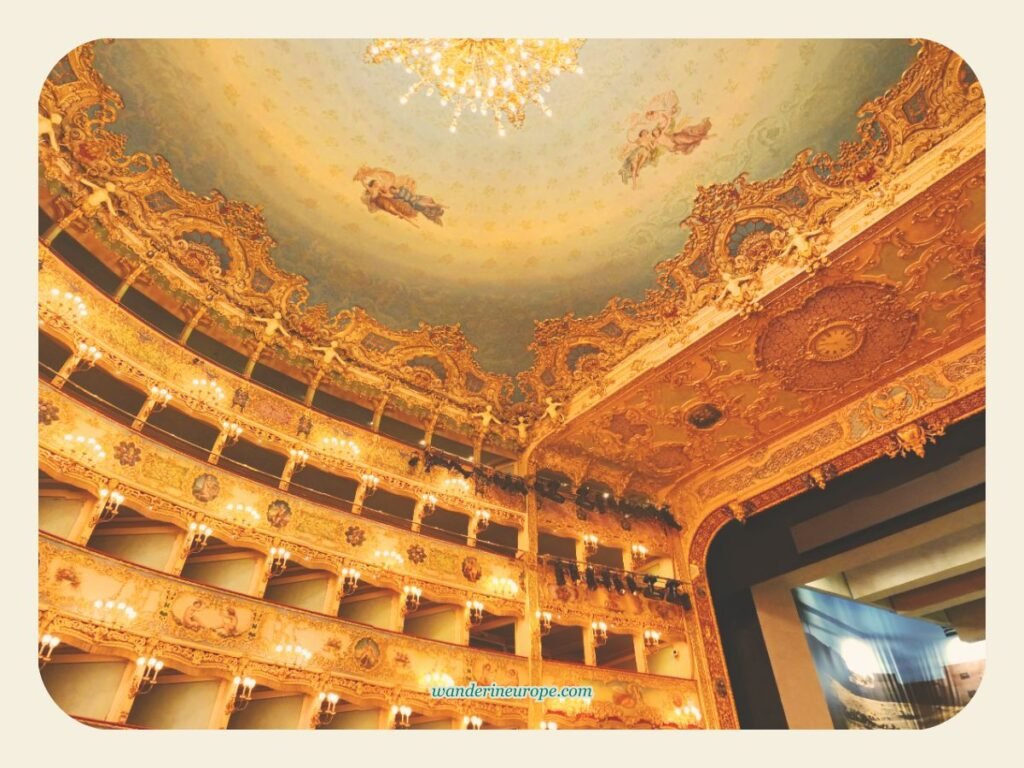

The sixth building on this list is something special. While its exterior isn’t flashy, its interior is truly breathtaking.
It’s called La Fenice, which means “the phoenix” in Italian, and it’s one of the most stunning theaters in the country. La Fenice is located right in the heart of Venice, just a short walk from famous landmarks like the Rialto Bridge and St. Mark’s Cathedral. You can get from the cathedral to La Fenice in only five minutes.
La Fenice was originally designed in the Venetian neoclassical style, and despite multiple fires and reconstructions, this style has been carefully preserved. You can still see its neoclassical influence on the facade, which features sculptures representing the performing arts. Above the balcony, there are masks of comedy and tragedy, along with sculptures of Melpomene, the muse of tragedy, and Terpsichore, the muse of dance.
Inside, the opera house features a breathtaking interior with lavish gold decorations, intricate stucco work, and plush furnishings reminiscent of late-Empire luxury.
La Fenice has several sections, including the foyer, royal box, Sale Apollinee, and Sale Dane, but the auditorium and royal box stand out the most. Their rich red and gold décor, elegant chandeliers, and plush velvet seats create a truly stunning atmosphere. Some even argue it rivals the historic opera houses of Vienna, Paris, and Milan. When you visit, you can grab an audio guide to learn more about its history and architecture.
Curious about the history and why the theater’s name is La Fenice? Let me tell you the tragic but fascinating story of this beautiful building in Venice.
Imagine it’s 1790. A plot of land in Venice is cleared, making way for a grand vision—an opera house like no other. Architect Giannantonio Selva’s design is chosen from 29 proposals, and in just 18 months, La Fenice is born in April 1792. But true to its name, the Phoenix would not rise without facing fire.
In 1836, flames engulf the theater, reducing it to ruins. Yet within a year, La Fenice is rebuilt, restored to its former glory. Then in 1996, disaster strikes again—this time, arson reduces it to little more than walls. But once again, like a true phoenix, La Fenice rises, reopening in November 2004.
Through triumph and tragedy, La Fenice has been a stage for the extraordinary. It has premiered works by legendary composers of the bel canto era, including Rossini, Bellini, Donizetti, and Verdi. Its halls have echoed with the talents of world-renowned artists like Riccardo Chailly and Vladimir Temirkanov.
Today, La Fenice stands as a symbol of resilience and artistry. With world-class performances, it remains one of Venice’s most cherished cultural treasures, captivating audiences just as it has for centuries.

For more information about La Fenice, kindly check its official website.
Palazzo Contarini del Bovolo

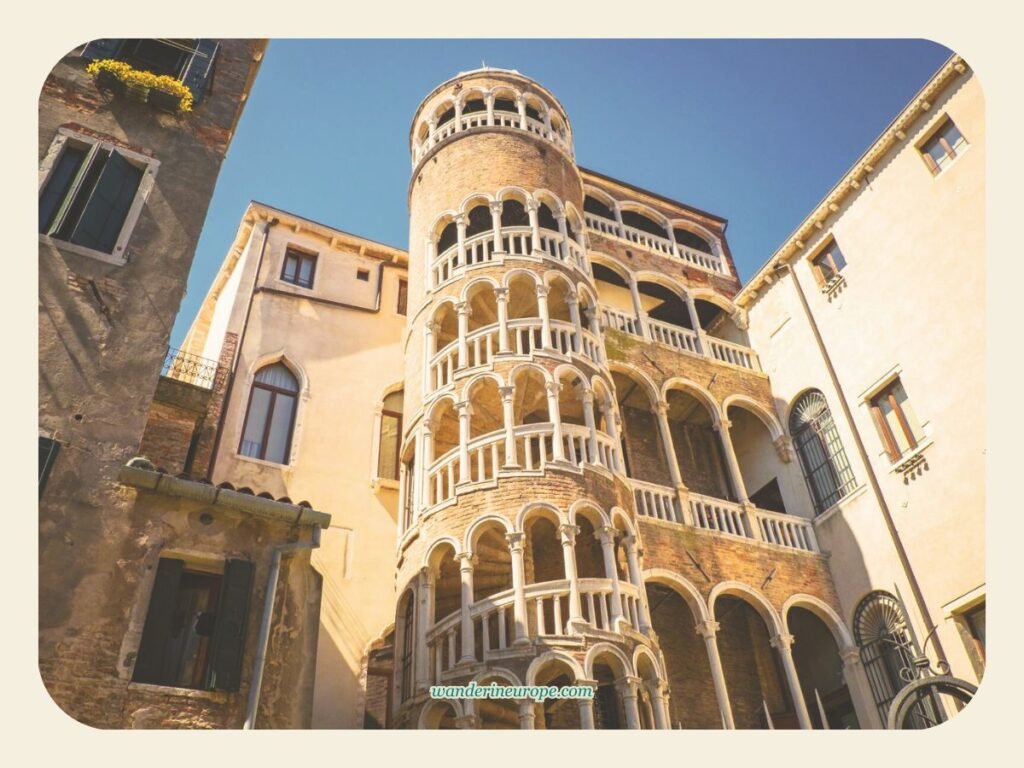
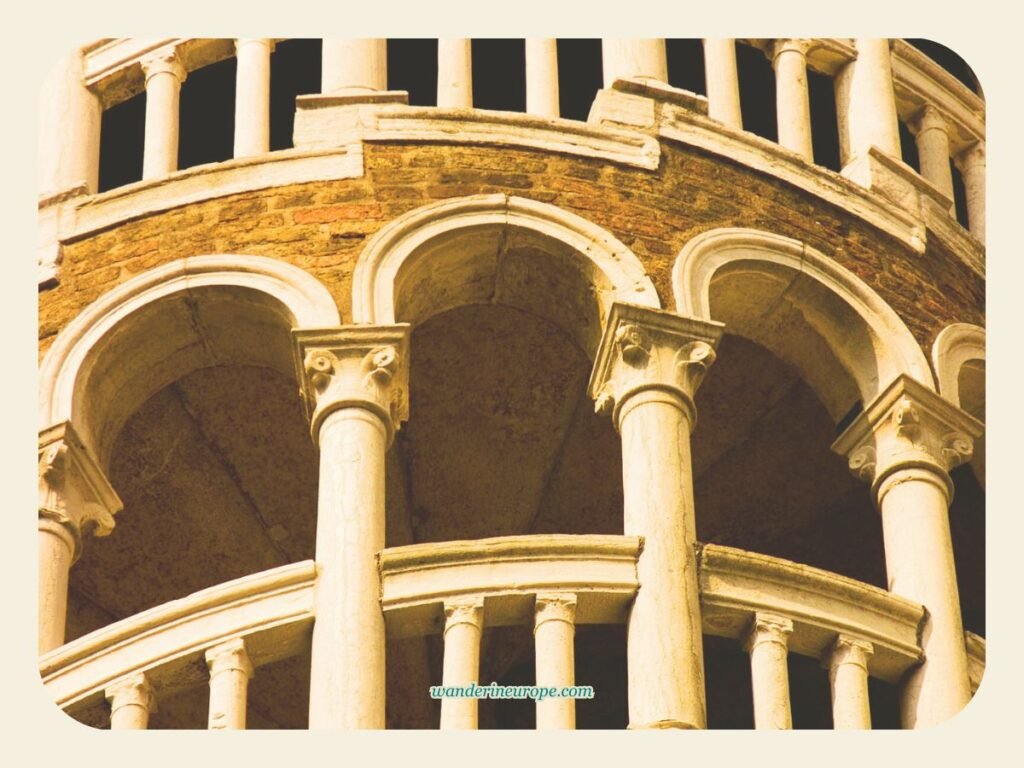
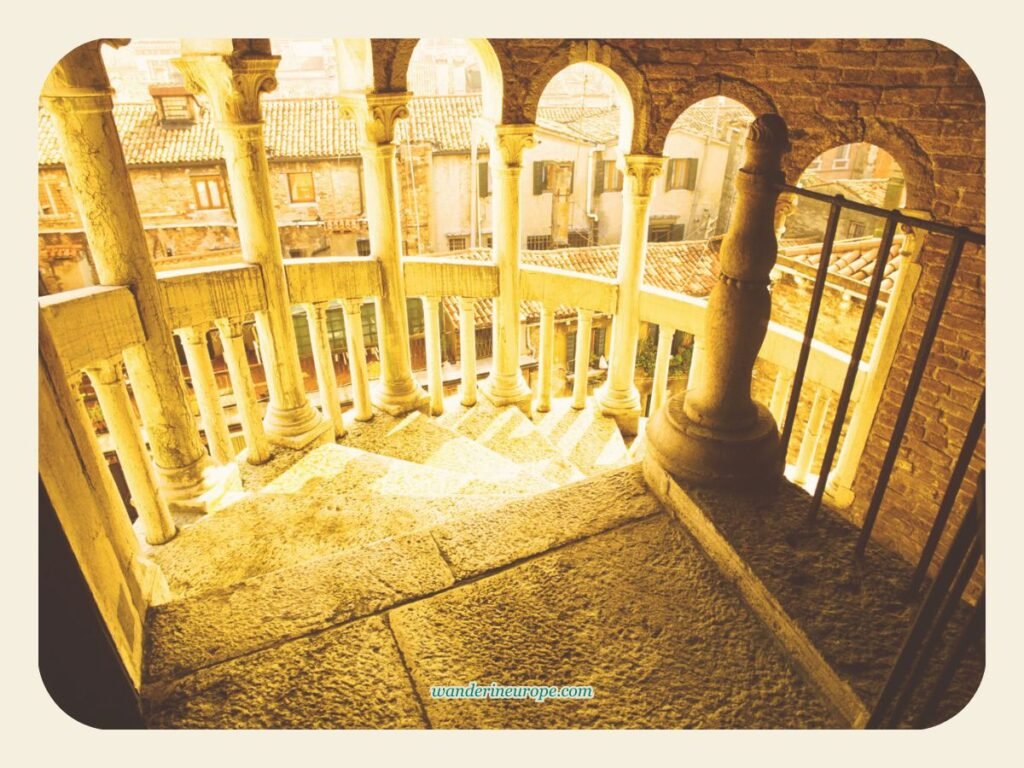
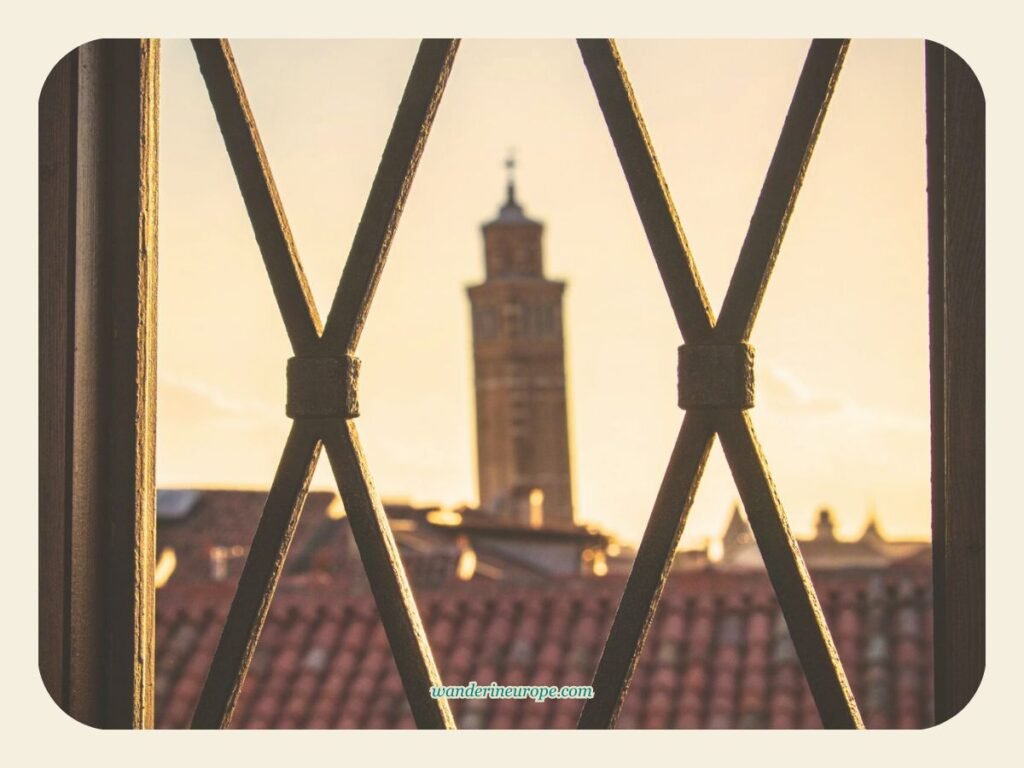

Just a short walk from La Fenice Theater, you’ll find Scala Contarini del Bovolo, one of the most charming spiral staircases in Venice. This hidden architectural gem is part of the quaint Palazzo Contarini del Bovolo, tucked away in the San Marco district. It is located somwhere between the Grand Canal, Rio de San Salvador, Rio di San Luca, and Rio Fuseri.
Built in 1499, the Scala Contarini del Bovolo, or “Staircase of the Snail,” is a notable example of Venetian architecture. This spiral staircase winds up a circular Byzantine-style tower, linking the palace’s loggias to a charming courtyard below. Its series of round-headed arches create a distinctive, rhythmic pattern that is unique in Venice.
While the staircase primarily reflects Byzantine influences, it also incorporates Renaissance elements, with a strong focus on symmetry, proportion, and geometry—hallmarks of the era’s architectural style.
The Scala Contarini del Bovolo also has some Gothic features. If you look carefully, you can spot traces of this older style both inside and outside the building. On the side facing Saint Mark, you’ll see parts of a detailed floral design, while the main façade looking over the Rio di San Luca still keeps its original late-Gothic look.
The thing is, the Palazzo Contarini del Bovolo, where the Scala Contarini del Bovolo is located, is more than just an architectural gem in Venice. The palazzo’s 28-meter high tower offers a panoramic view of the city’s skyline. From this vantage point, you can see landmarks like the tower in Saint Mark’s Square and the dome of the Basilica di Santa Maria della Salute.
The palace, which was once a lodging house, also hosted the German astronomer Wilhelm Tempel. From the top of the tower, he used a telescope to discover the comet C/1859 and the Merope Nebula in the Pleiades. Then, in 1952, American director Orson Welles picked this spot for his film adaptation of Shakespeare’s Othello, showing off the elegant Scala Contarini del Bovolo in all its beauty.
For updates and more information, please see the official website of Scala Contarini del Bevolo.
Procuratie

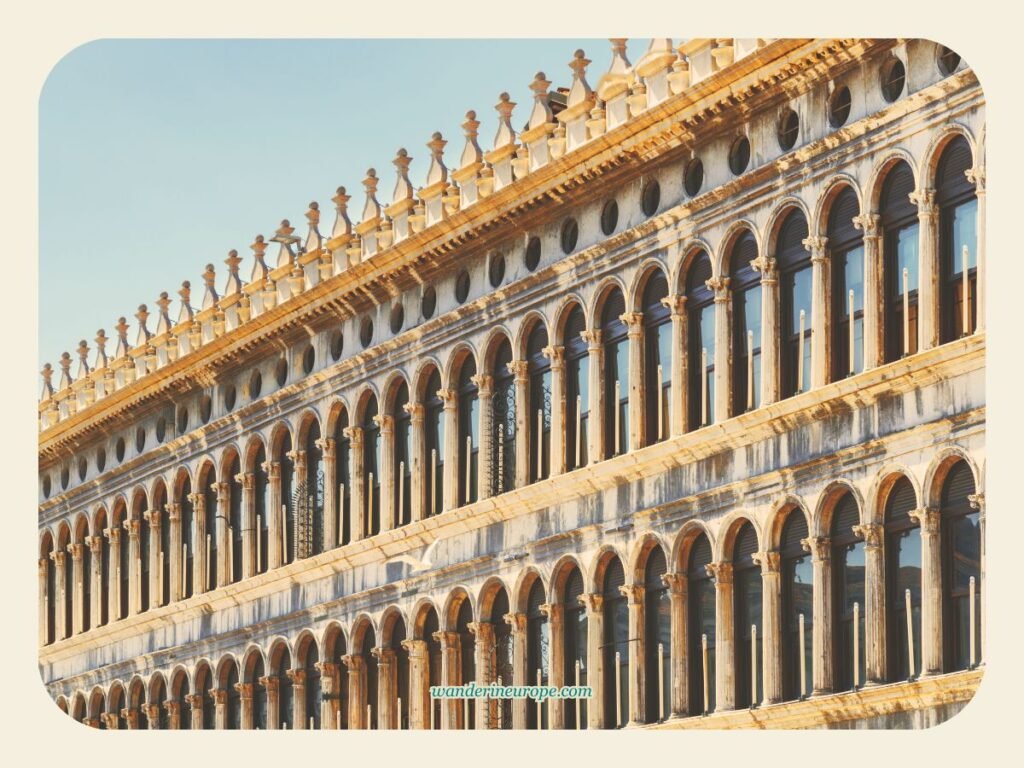
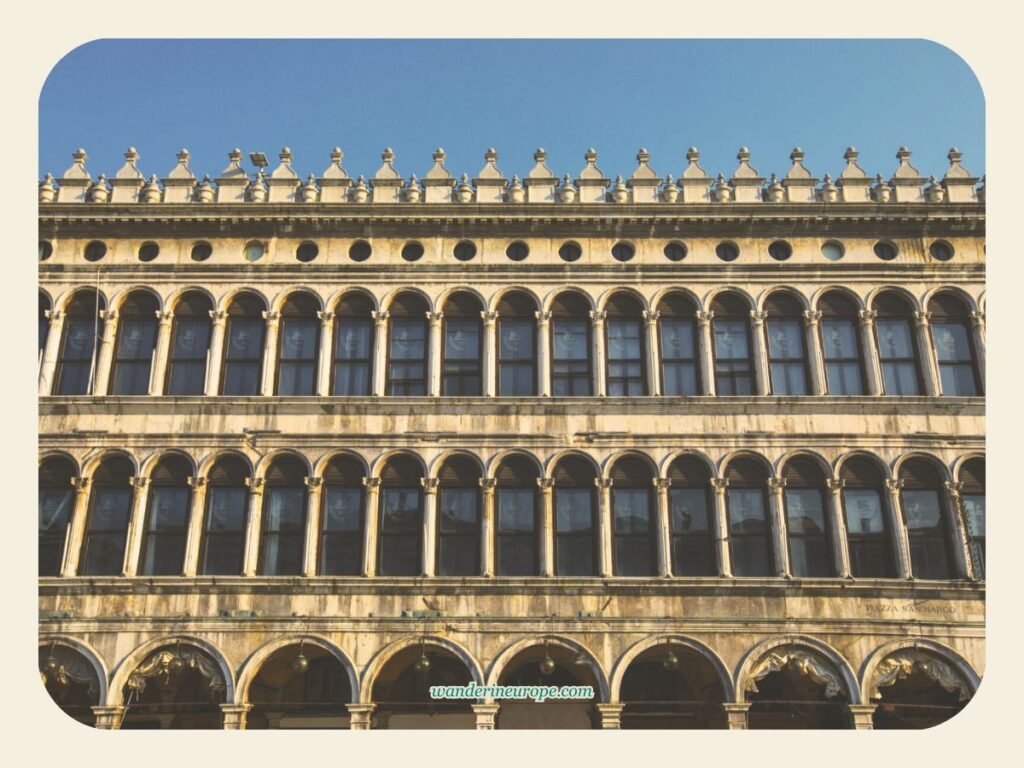
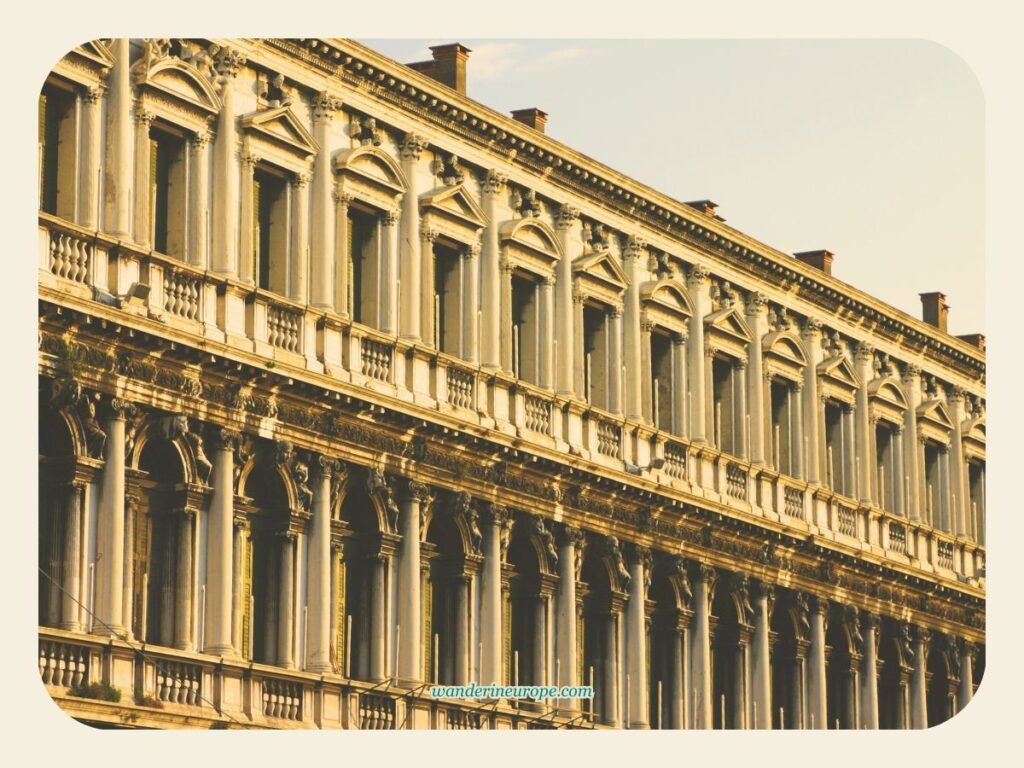
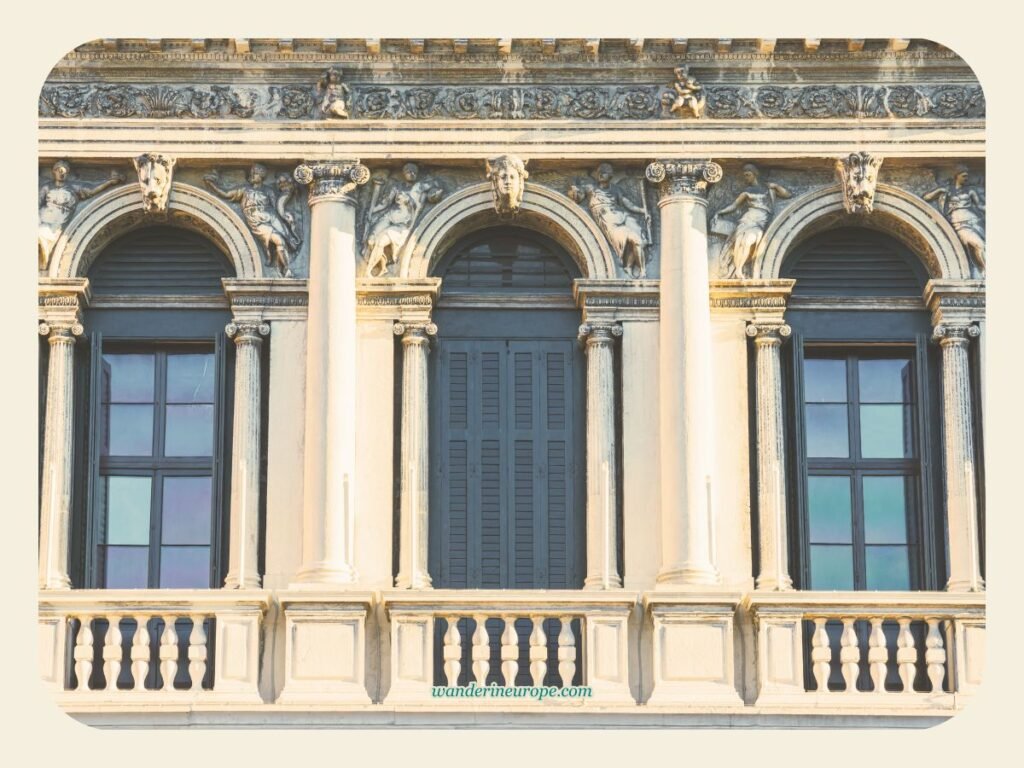

For centuries, Saint Mark’s Square has been the heart of Venice, showcasing the impressive style of Venetian architecture. It’s home to not only Saint Mark’s Basilica and the Doge’s Palace but also the Procuratie, another building that makes the square even more beautiful.
The Procuratie are three buildings that surround Saint Mark’s Square in Venice, Italy, almost like arms wrapping around the square. Each one has its own name and style:
- The Procuratie Vecchie is on the north side. It’s an old building finished in the early 1500s, designed in the Early Renaissance style. Imagine walking around a building that’s been there for over 500 years!
- The Procuratie Nuove is on the south side. This one was built to house the official residences of the procurators. It was completed between the late 1500s and the mid-1600s, designed in the High Renaissance style.
- The Procuratie Nuovissime, also called the Napoleonic Wing, is the newest of the three. Built during the French occupation in the early 1800s, it’s designed in the Neoclassical style.
Recently, the Procuratie Vecchie was restored by David Chipperfield Architects Milan. The team focused on preserving its historic architecture while adding new features to make it more practical.
Santa Maria di Nazareth Church


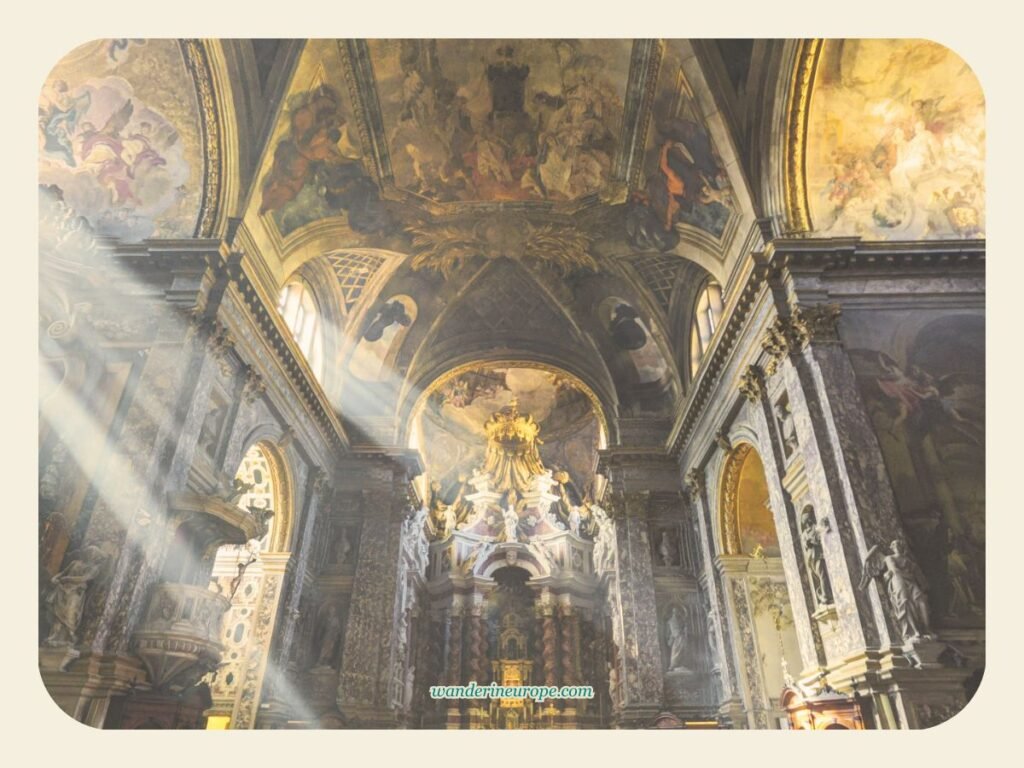
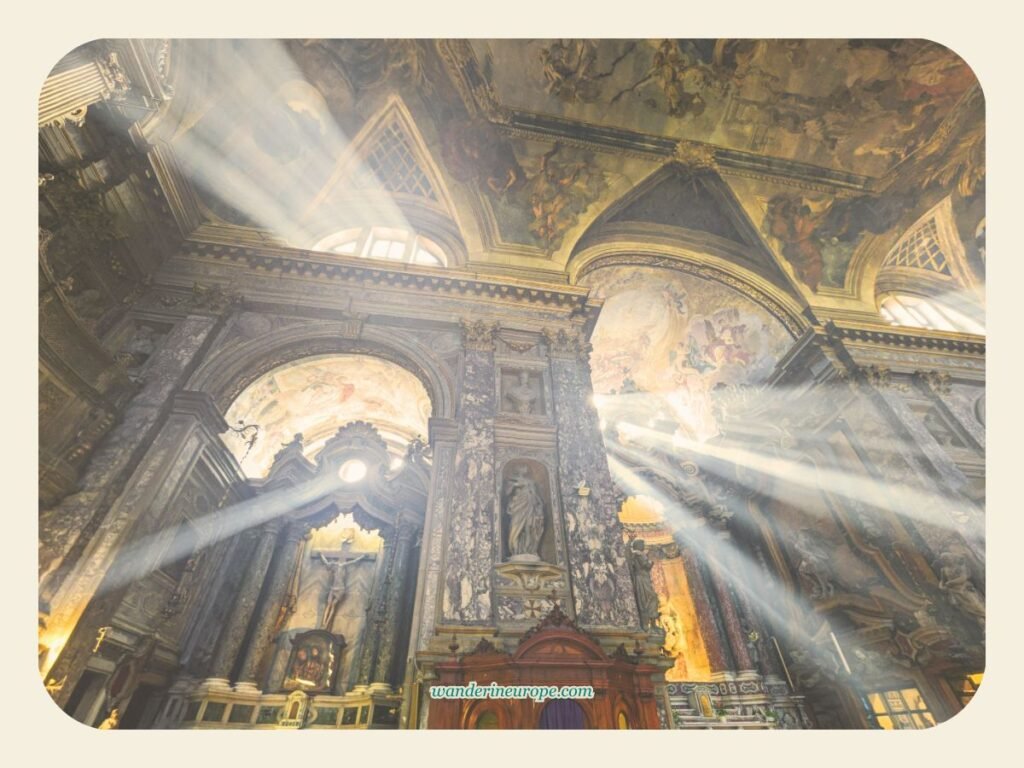
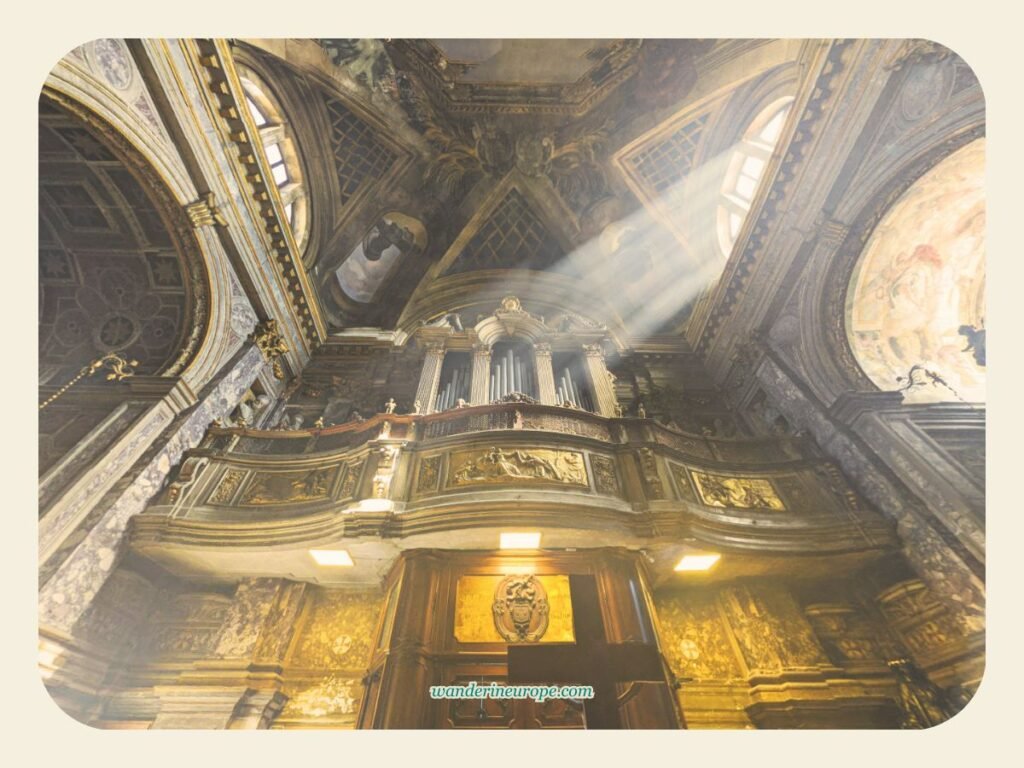

The Venice Grand Canal is lined with stunning buildings, including two stunning churches. One is the Basilica di Santa Maria della Salute, and the other is the Santa Maria di Nazareth Church. You’ll find the Santa Maria di Nazareth Church conveniently located near the Venezia Santa Lucia railway station in Cannaregio, a neighborhood in the northern part of Venice.
The Santa Maria di Nazareth Church, also known as the Church of the Scalzi, is one of those hidden gems in Venice that many people walk right past without realizing what they’re missing. Built in the mid-17th century by the Barefoot Carmelite friars and designed by Baldassarre Longhena, this Baroque masterpiece was completed in 1689.
Frankly, it’s surprising how many visitors overlook this beautiful church. It may not be as massive as Saint Mark’s Basilica, but the architecture is breathtaking.
Inside, stunning religious artwork fills every corner. The nave is lined with intricately detailed altars, and right when you step in, you’ll spot a statue of St. John of the Cross on your right, believed to be the work of Falconi. Look around, and you’ll see statues of Faith, Hope, and Charity by Tommaso Rues. Keep exploring, and you’ll come across a striking statue of St. Sebastian from 1669, complete with bronze bas-reliefs, also thought to be Falconi’s creation.
The most striking feature of this church is its vaulted ceiling. It once held a major fresco by Giambattista Tiepolo, showing the Translation of the House of Loreto. Unfortunately, the artwork was destroyed during an Austrian bombardment in 1915. To restore the space, artist Ettore Tito created new paintings and frescoes. Tiepolo’s original work maybe gone, but you can still see some of its surviving pieces in the Gallerie dell’Accademia.
Another highlight of the Santa Maria di Nazareth Church is its high altar, a true masterpiece by Fra Giuseppe Pozzo. The tabernacle is framed by twisted columns and topped with a stunning golden crown above a statue of Mary—it’s an impressive sight to see!
The church is free to enter but do not forget to check the official website of the church for updates and more information.
Scuola Grande di San Marco

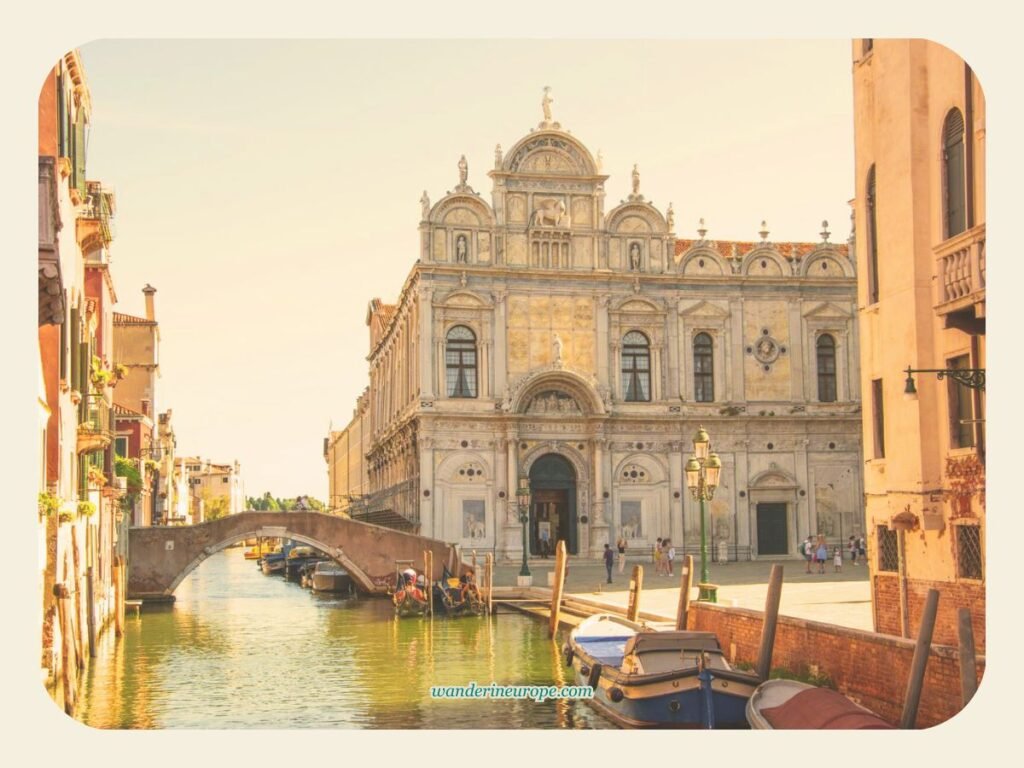
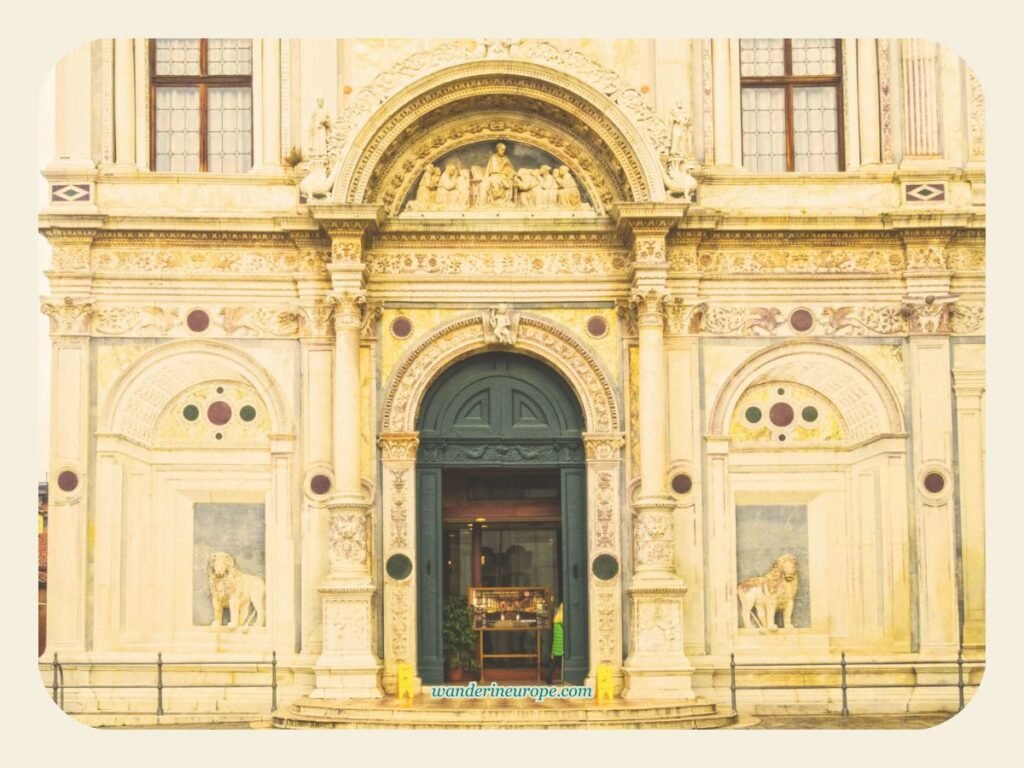
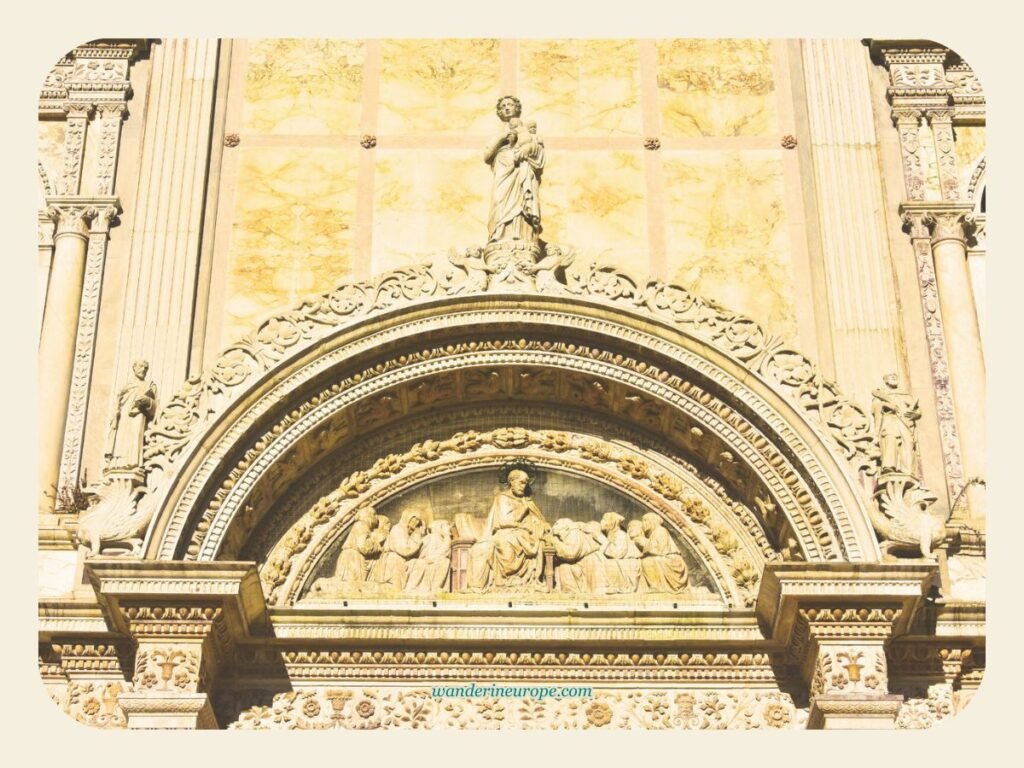
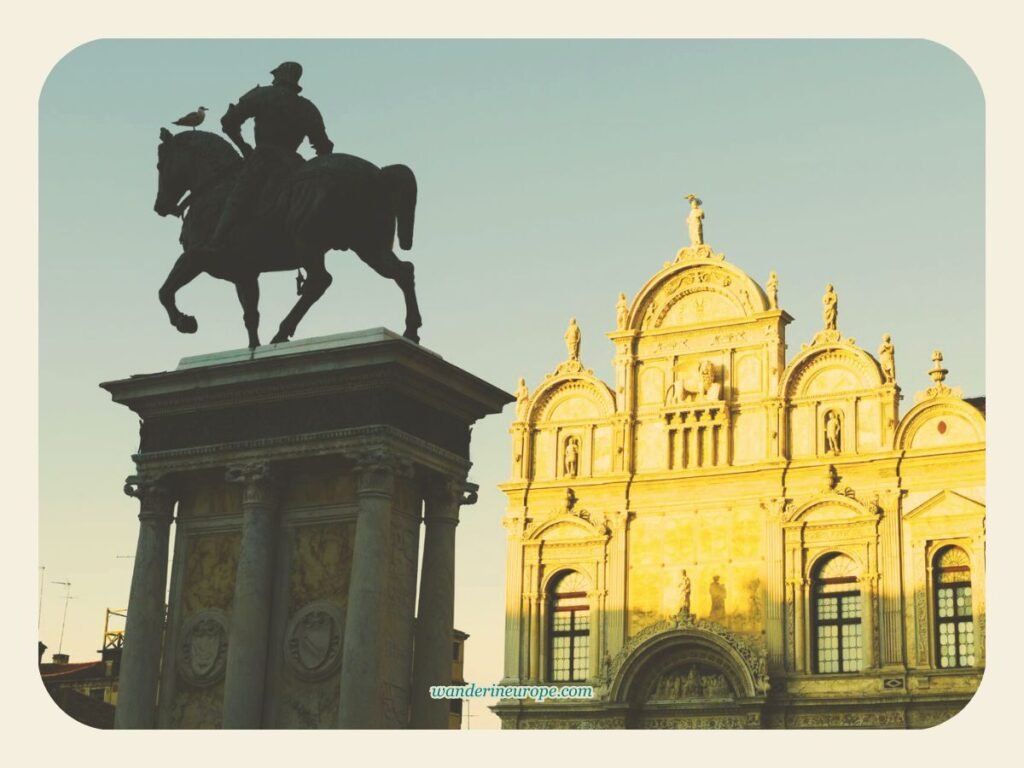

Last on our list of Venice’s top 10 beautiful buildings, but definitely not the least, is the Scuola Grande di San Marco. It’s in Castello, right next to the famous Basilica dei Santi Giovanni e Paolo.
(The closest vaporetto stop is Fondamente Nove. Just walk along the Fondamenta with the lagoon on your left until you reach a bridge. Turn right onto Fondamenta dei Mendicanti, and you’ll find it.)
Yes, from the canal, it’s clear that the Scuola Grande di San Marco is a stunning example of Renaissance architecture. While it has elements of Renaissance classicism, its many arches and niches give it a Byzantine touch, which is common in traditional Venetian styles. The façade is decorated with beautifully crafted niches, pilasters, and statues made of white or colorful marble that will definitely impress.
How about the history? The Scuola Grande di San Marco has a fascinating history that goes all the way back to 1260, when it was first built by the Confraternity of San Marco.
It was originally located where the Papadopoli Gardens are today but was moved in 1437 to a nearby area given by the Dominicans of the Basilica dei Santi Giovanni e Paolo for a new building. Unfortunately, a big fire in 1485 destroyed it. But instead of giving up, the members raised money to rebuild. Over the next 20 years, with a new design by Pietro Lombardo, the building was reconstructed, and Mauro Codussi later finished the façade.
Between 2000 and 2005, the façade was restored with the help of Save Venice Inc., the Getty Grant Program, and other donors. Today, the building houses a hospital and is an amazing sight when you pass by on the Fondamenta dei Mendicanti canal in Venice.
For more information, please check the official website of Scuola Grande di San Marco.
From great hotel deals to skip-the-line tickets and affordable eSim to cheap rentals, click here for the best hotel deals and more travel discounts.
Walking Route & Sightseeing Map of Venice’s Beautiful Buildings
I hope you enjoyed exploring Venice’s amazing landmarks! If you’re planning to visit soon, I’ve got some good news—I have a simple gift for you that will help you see these attractions more easily. Here’s my map, and feel free to use it!


Don’t Stop Exploring at Venice!
What I love about Northern Italy—home to Venice—is how close all the incredible destinations are. In just 30 minutes to two hours by train or car, you can explore breathtaking scenery and stunning landmarks, much like those in Venice. Check out my Northern Italy bucket list to discover more of the beauty this region has to offer!
For a convenient, unique, or more enriching visit, check out these experiences and services:


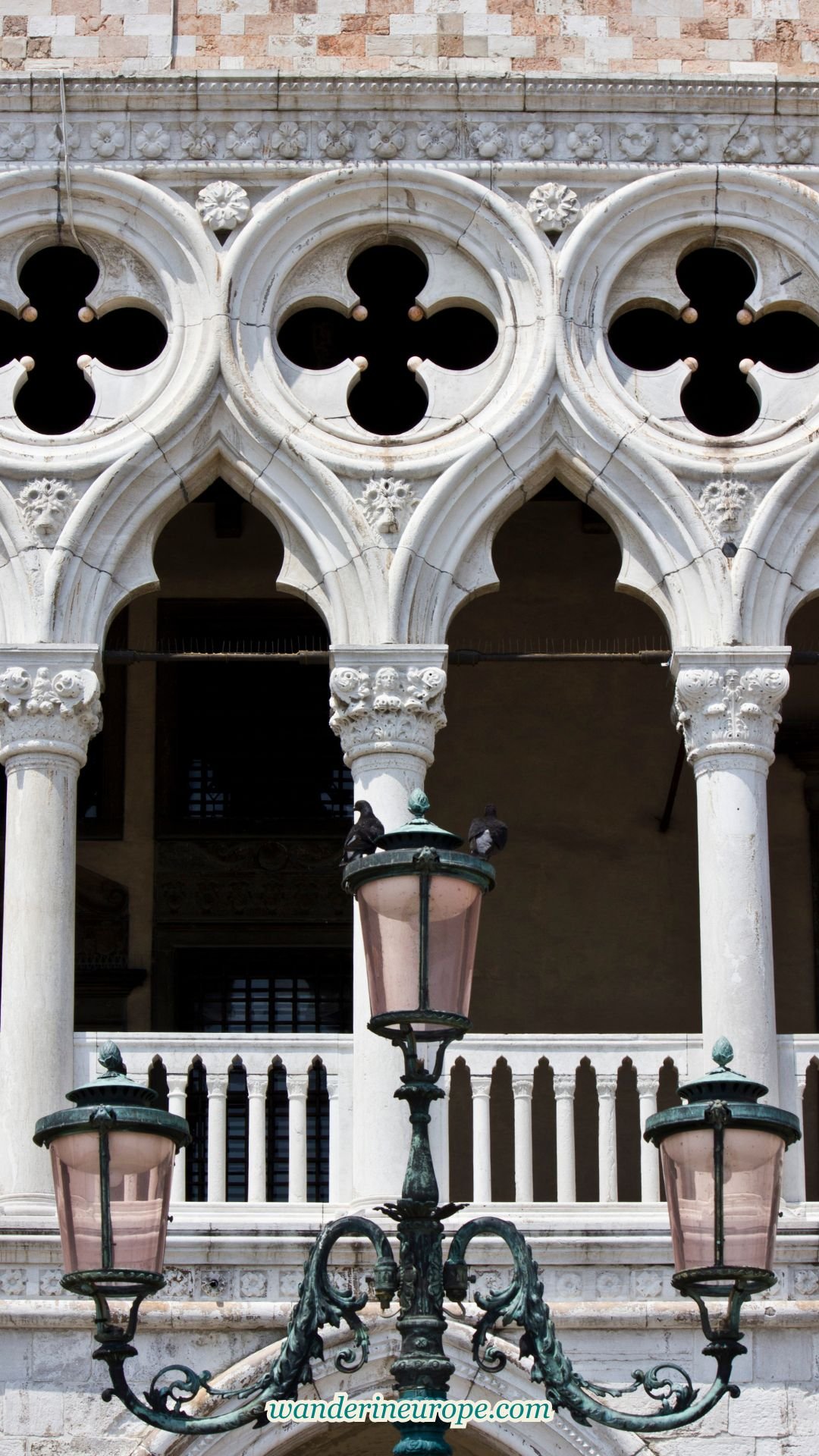
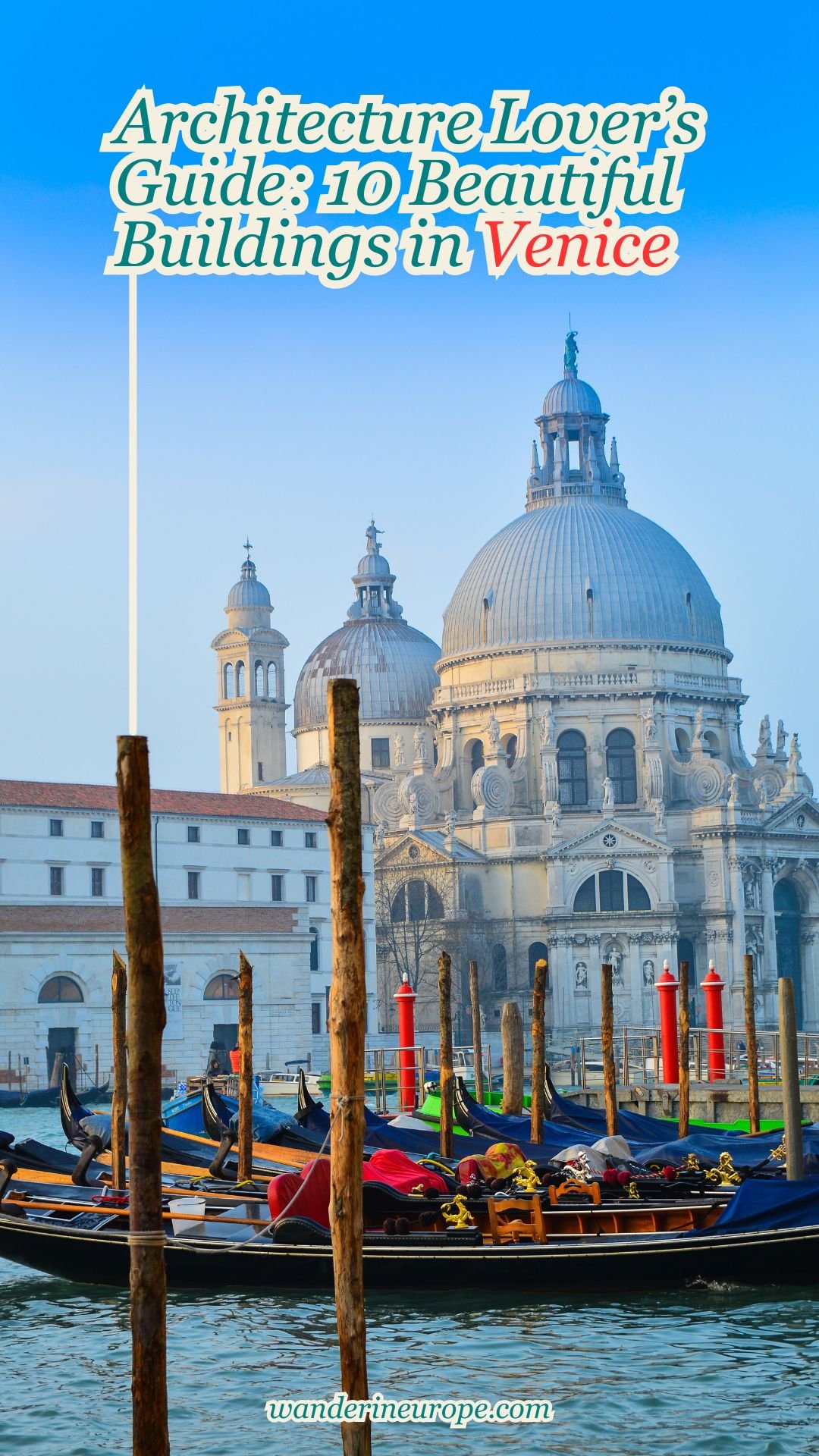
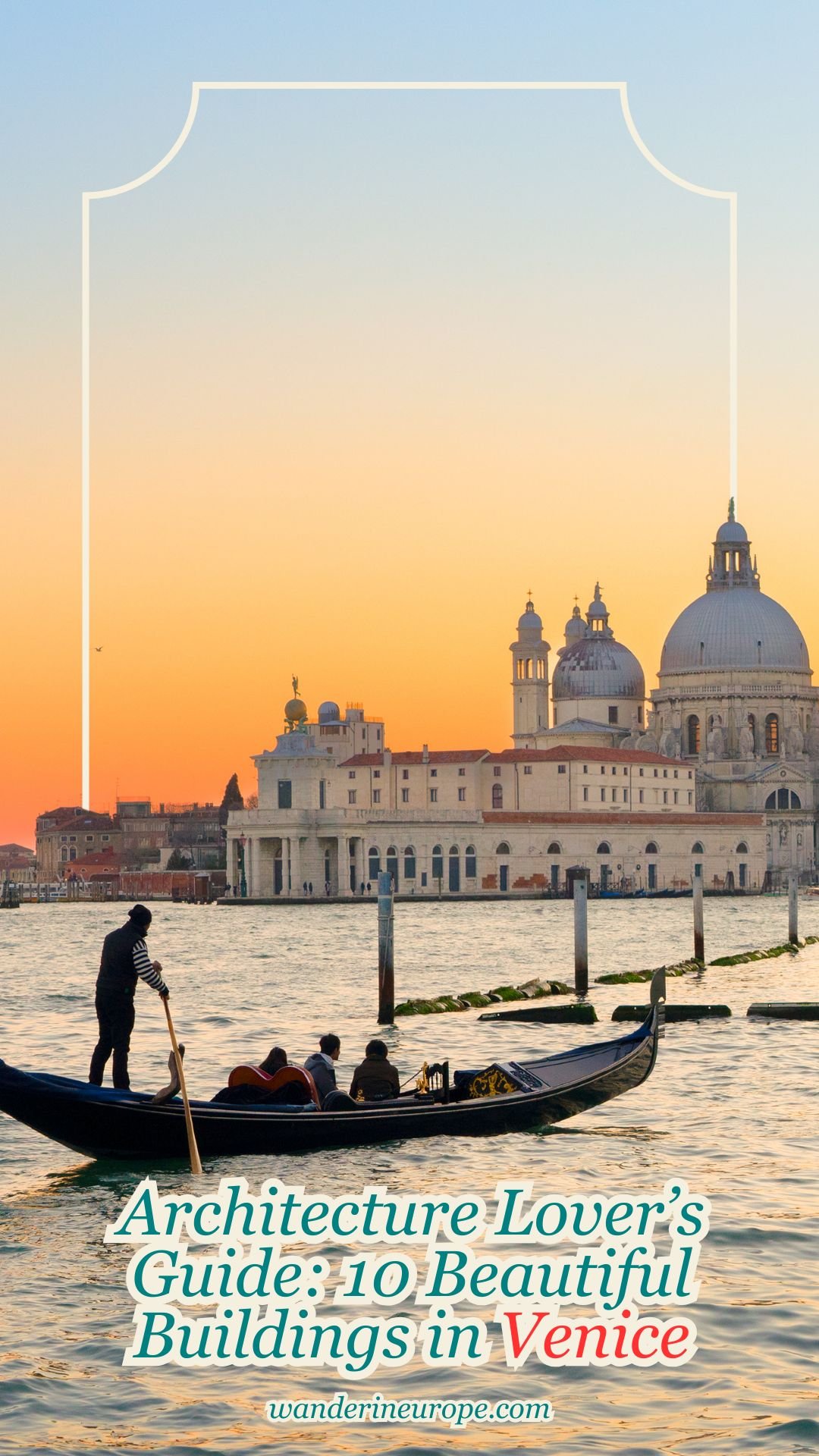
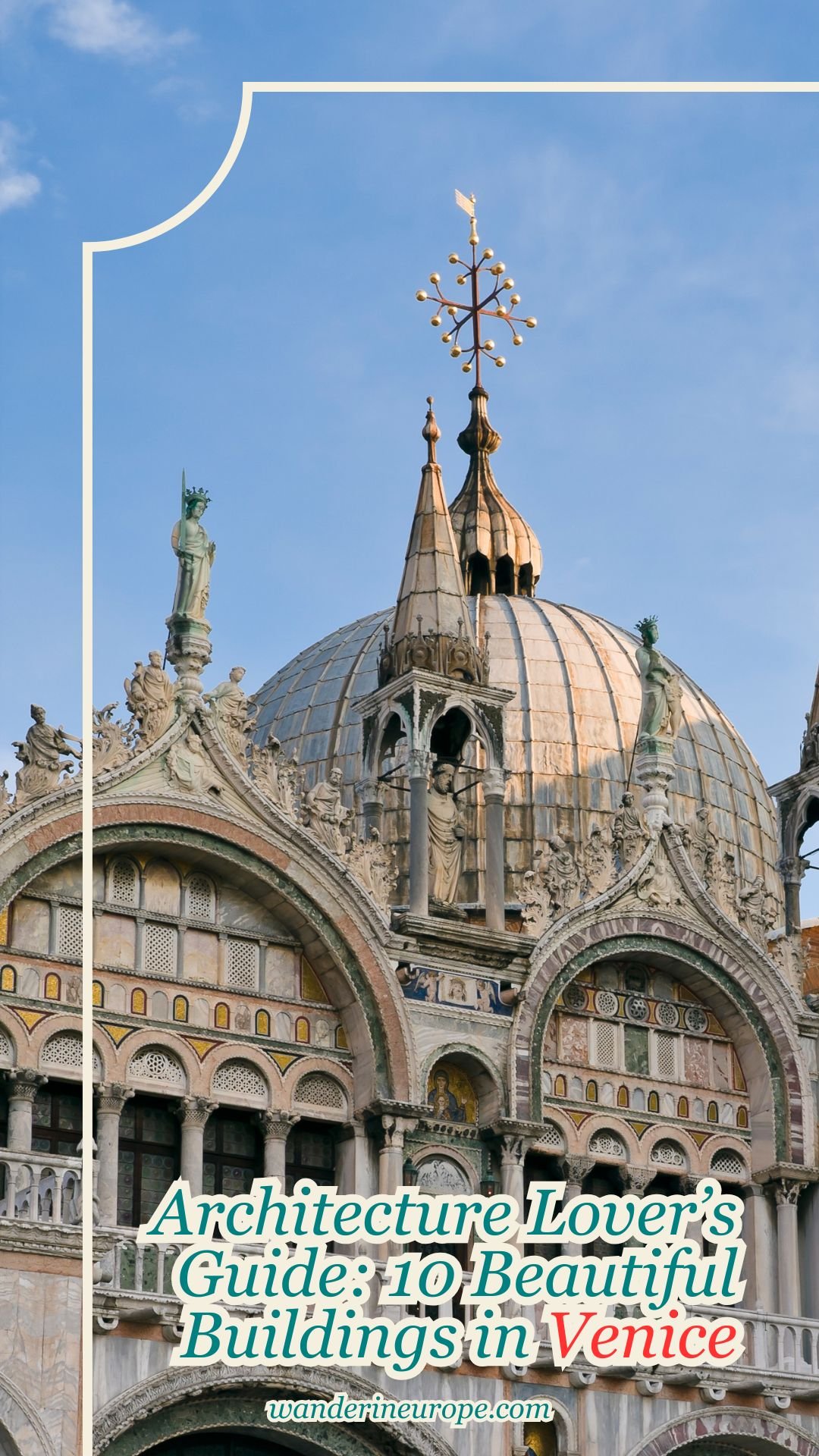
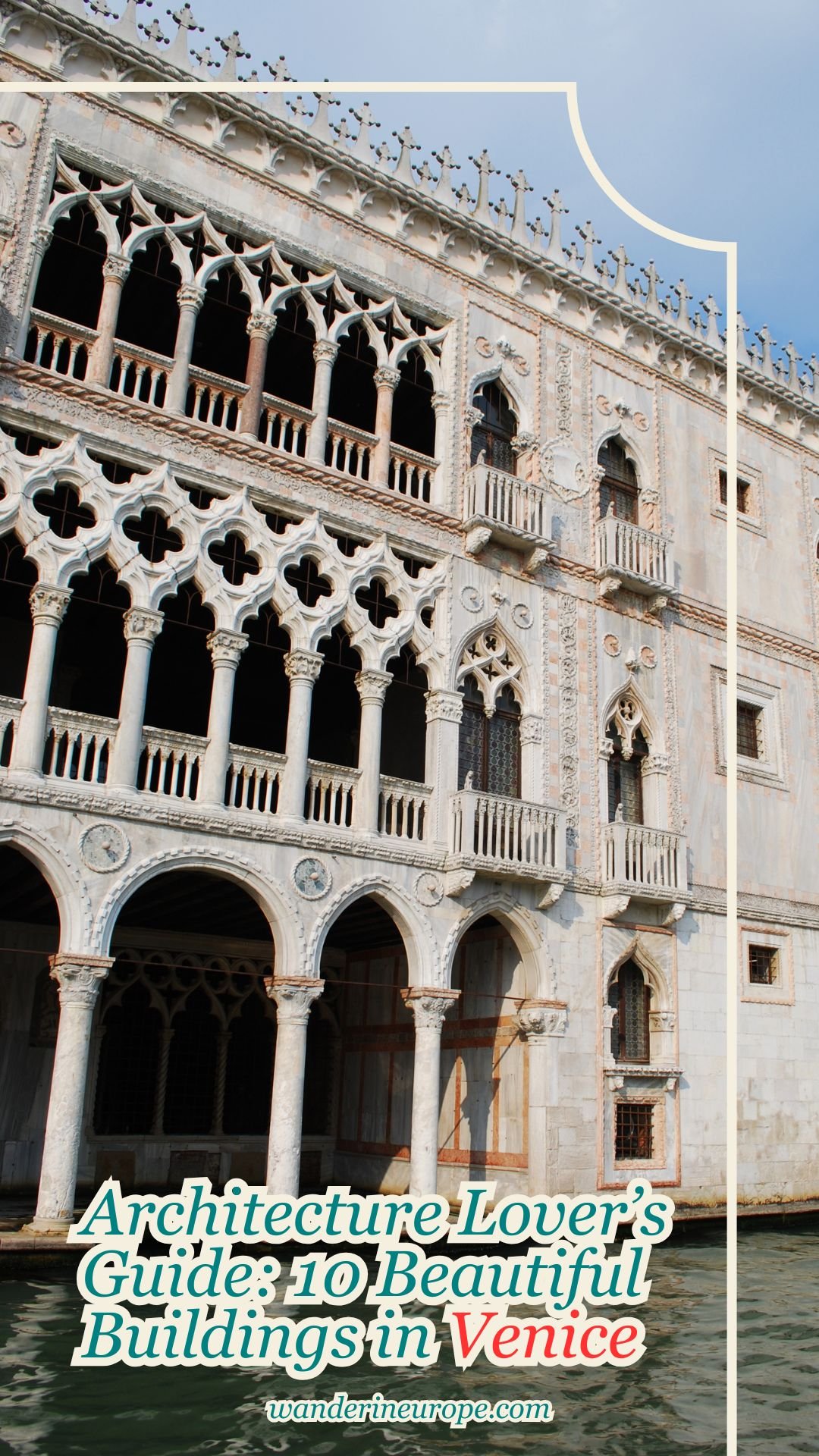
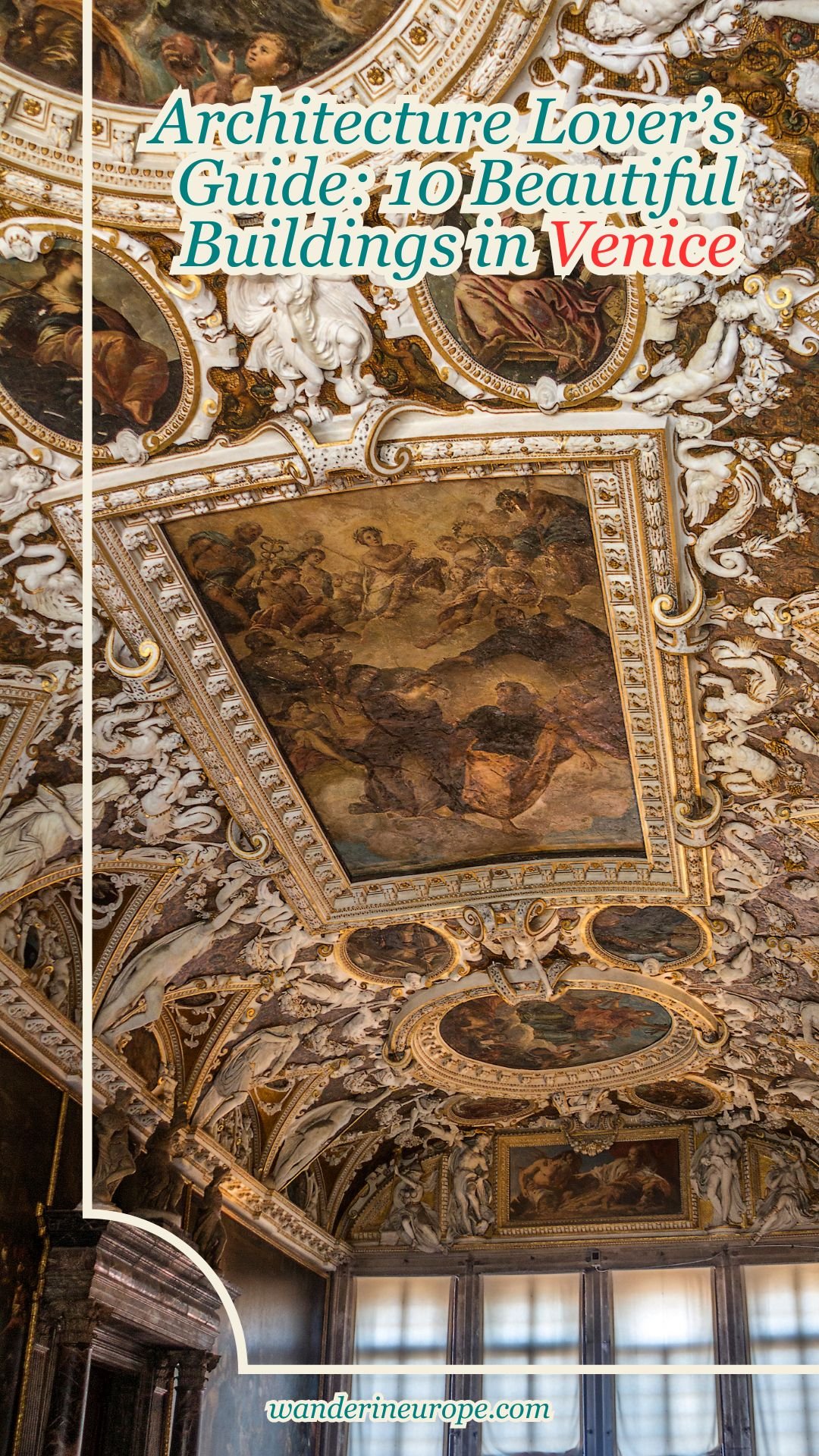
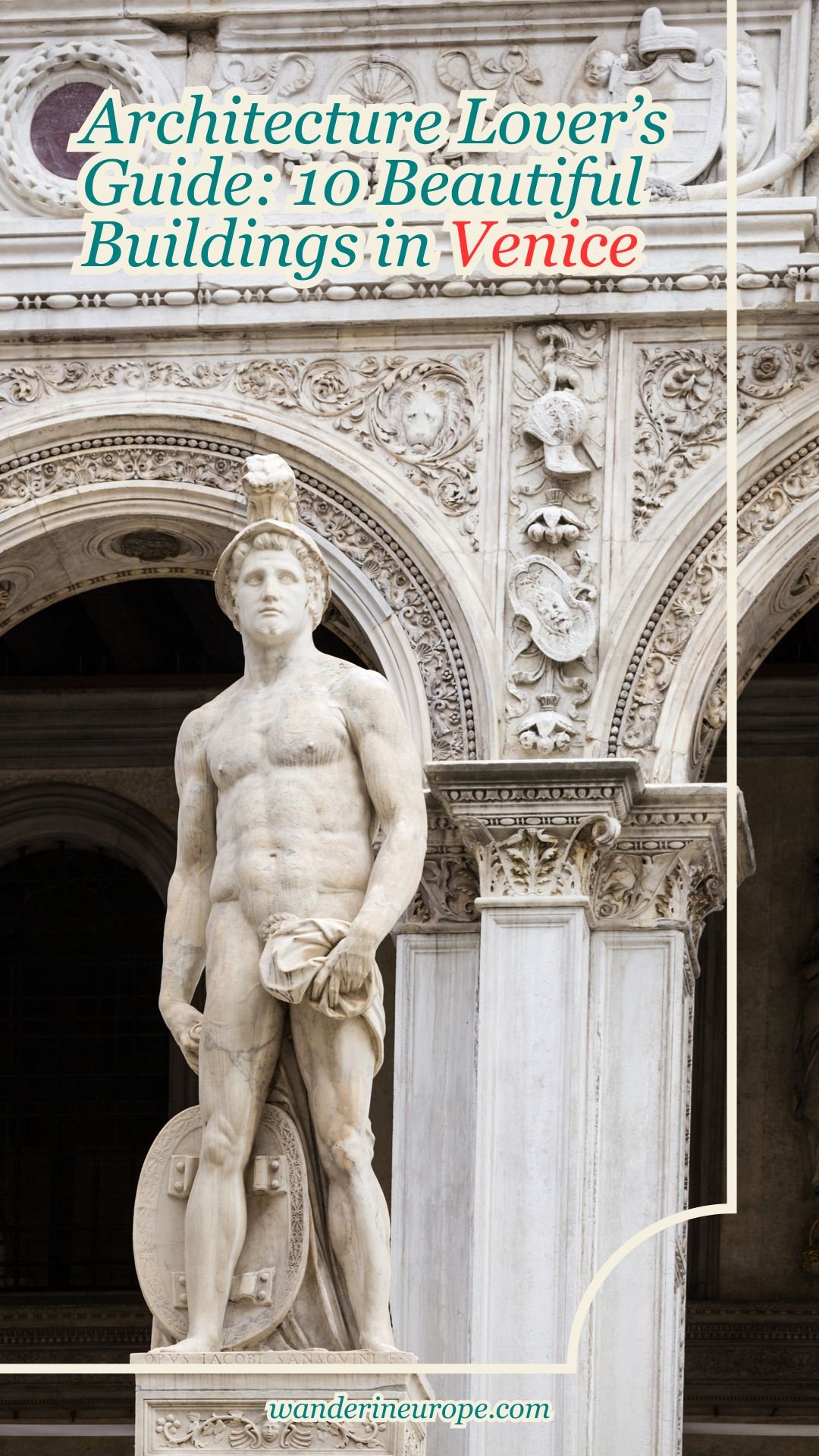
Pin this to save it for later or bookmark it to read anytime.

